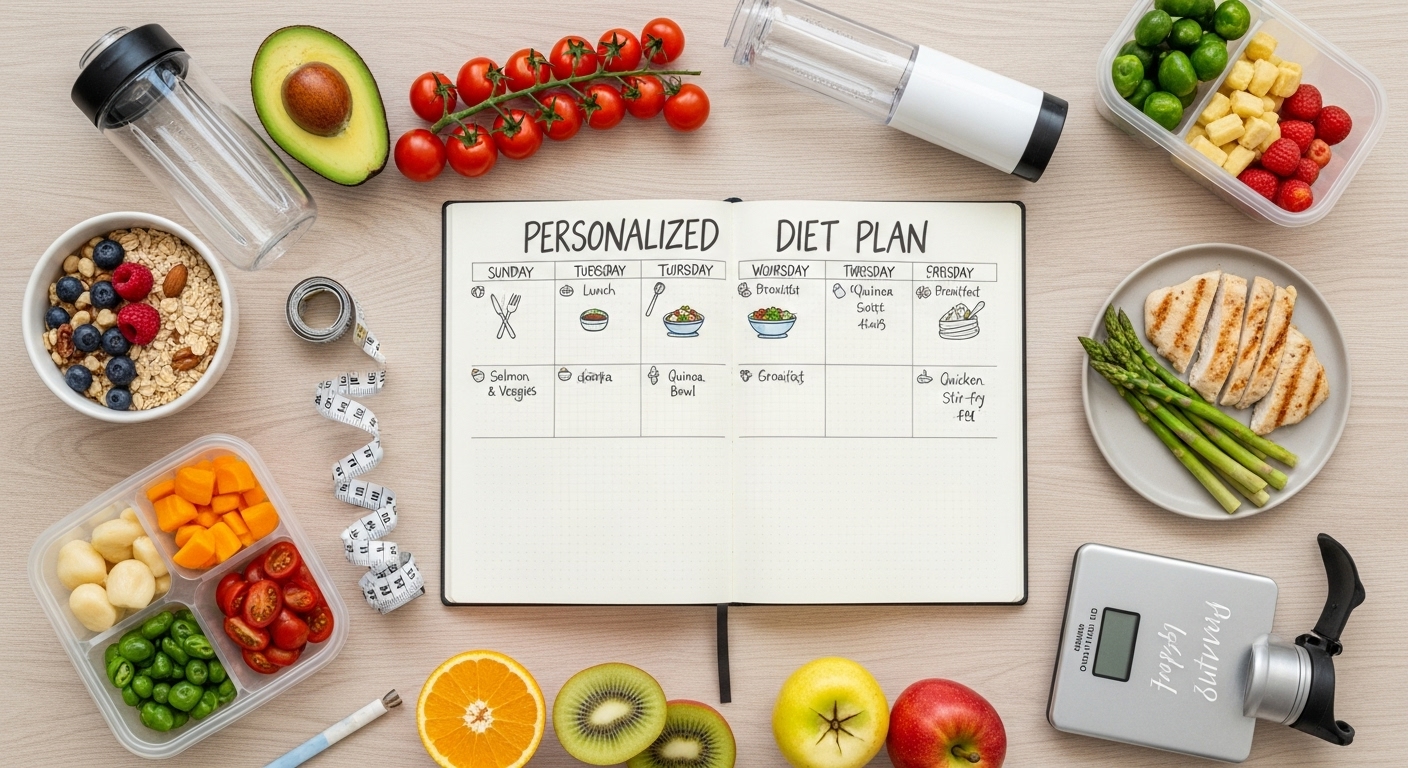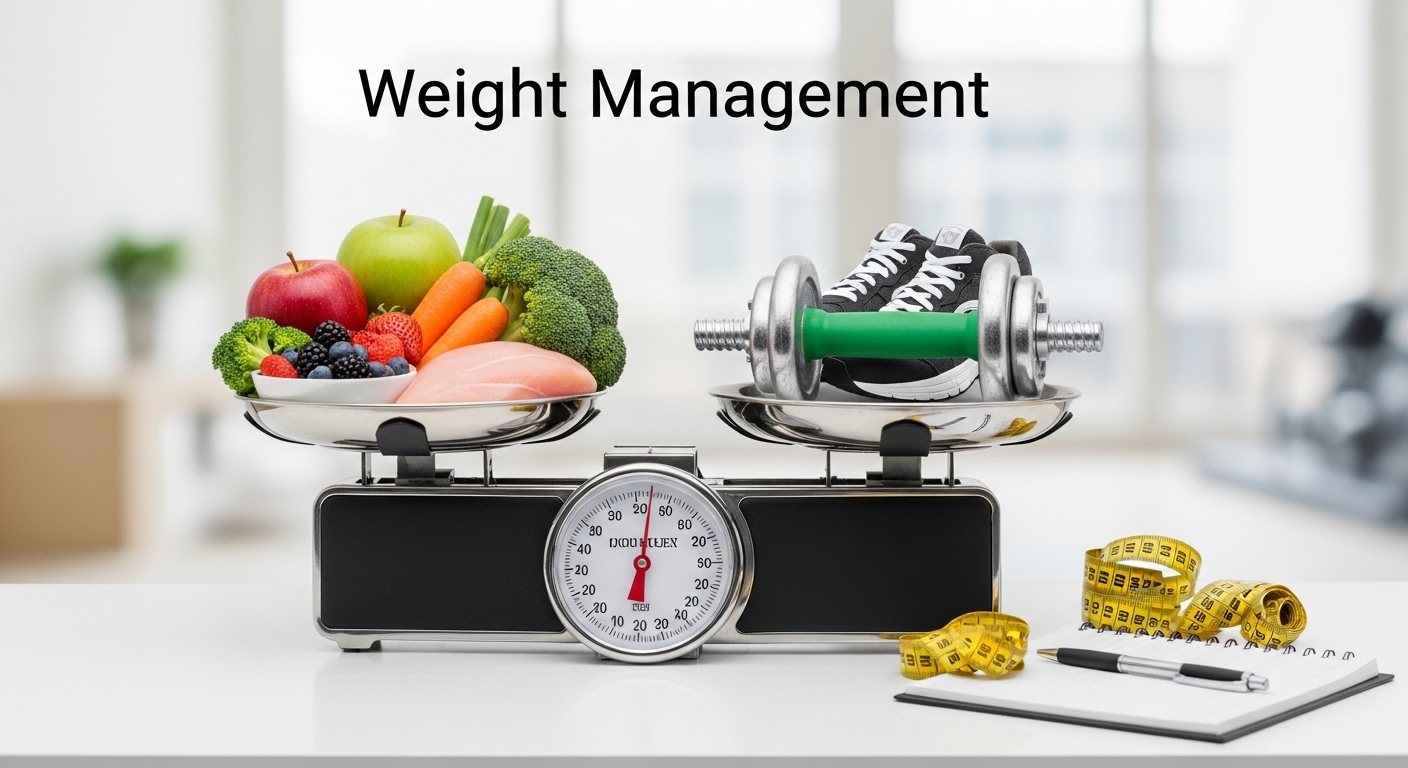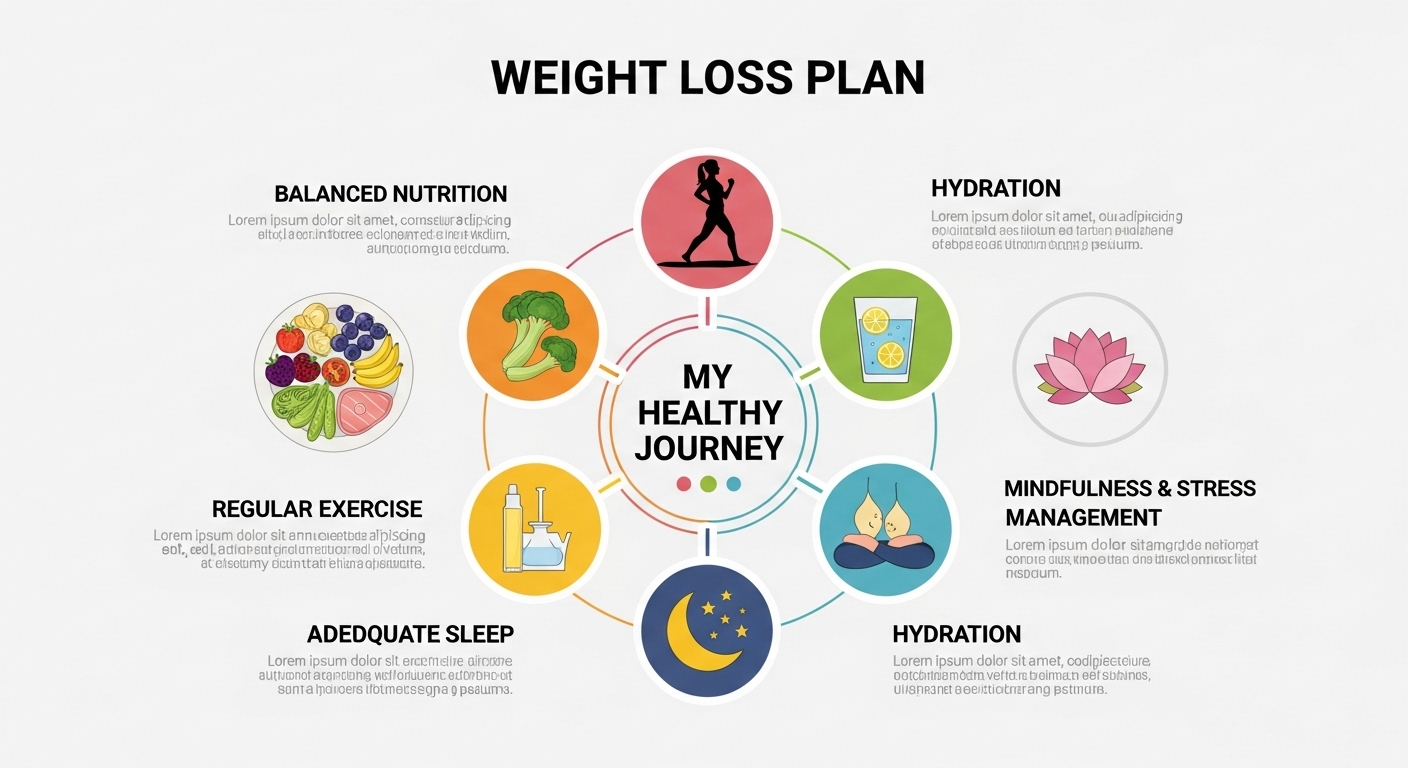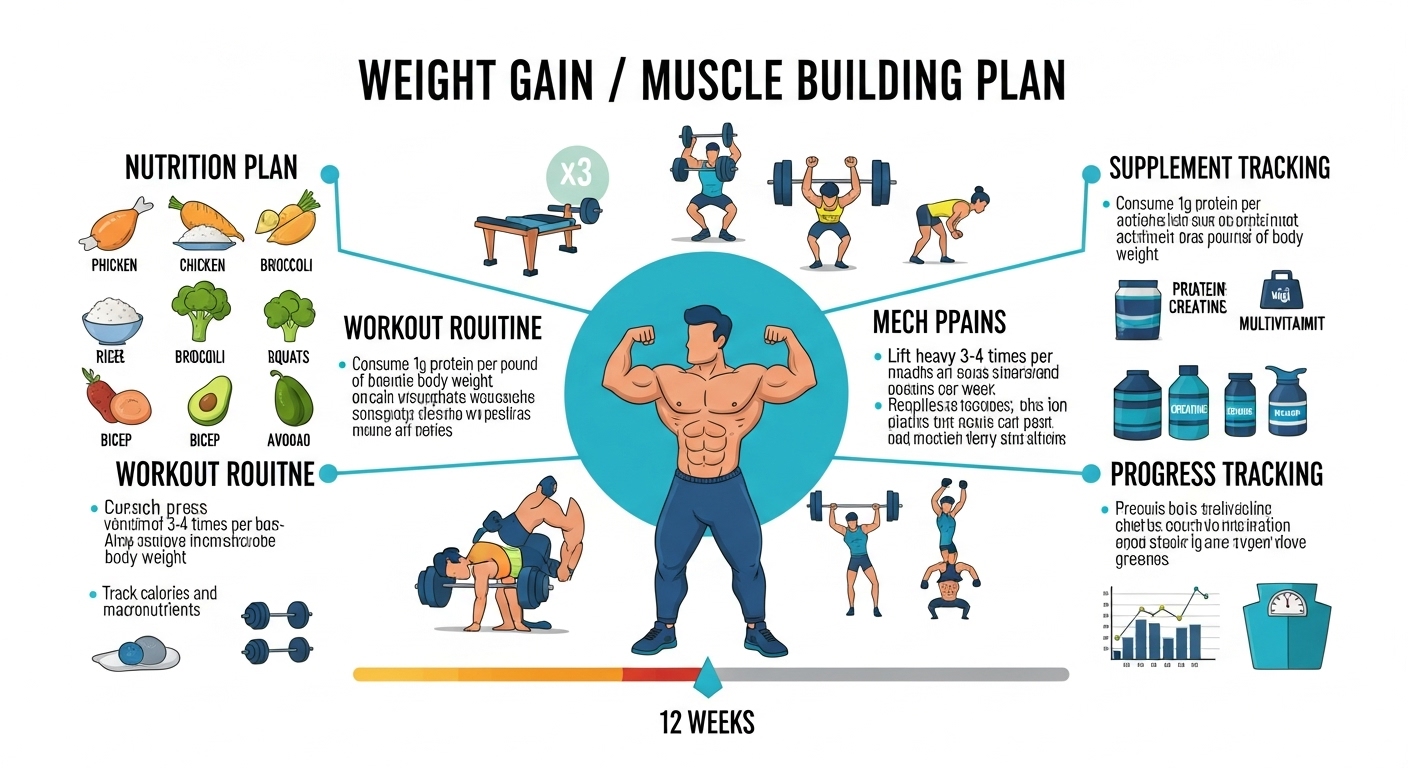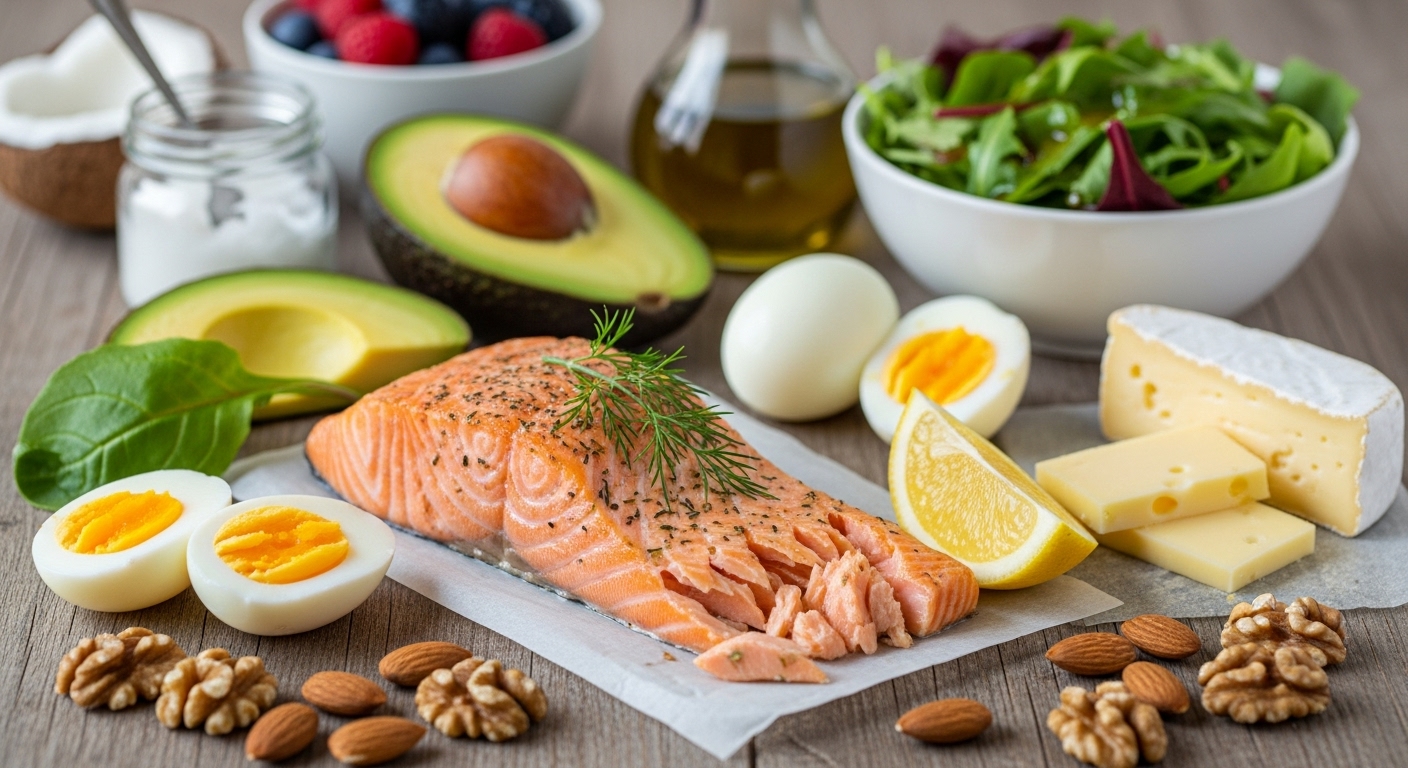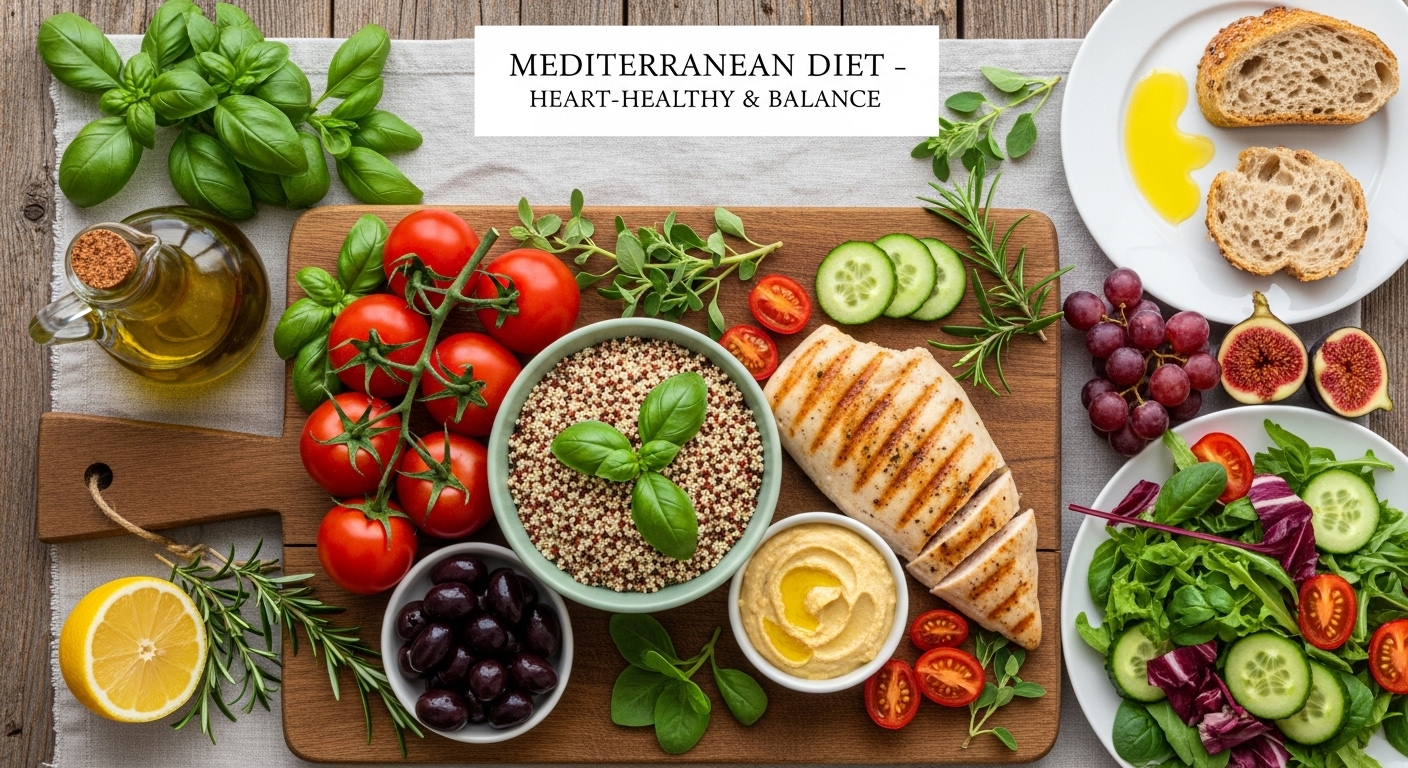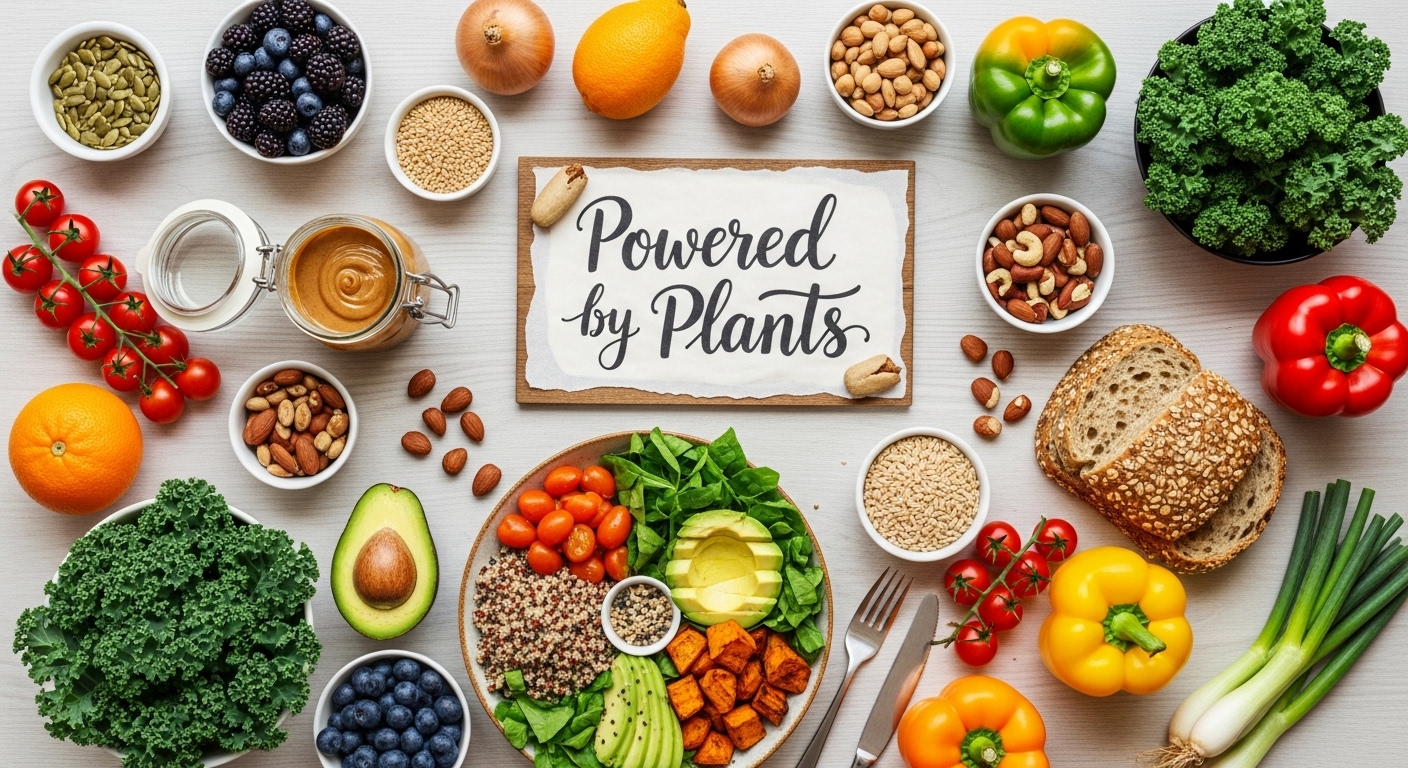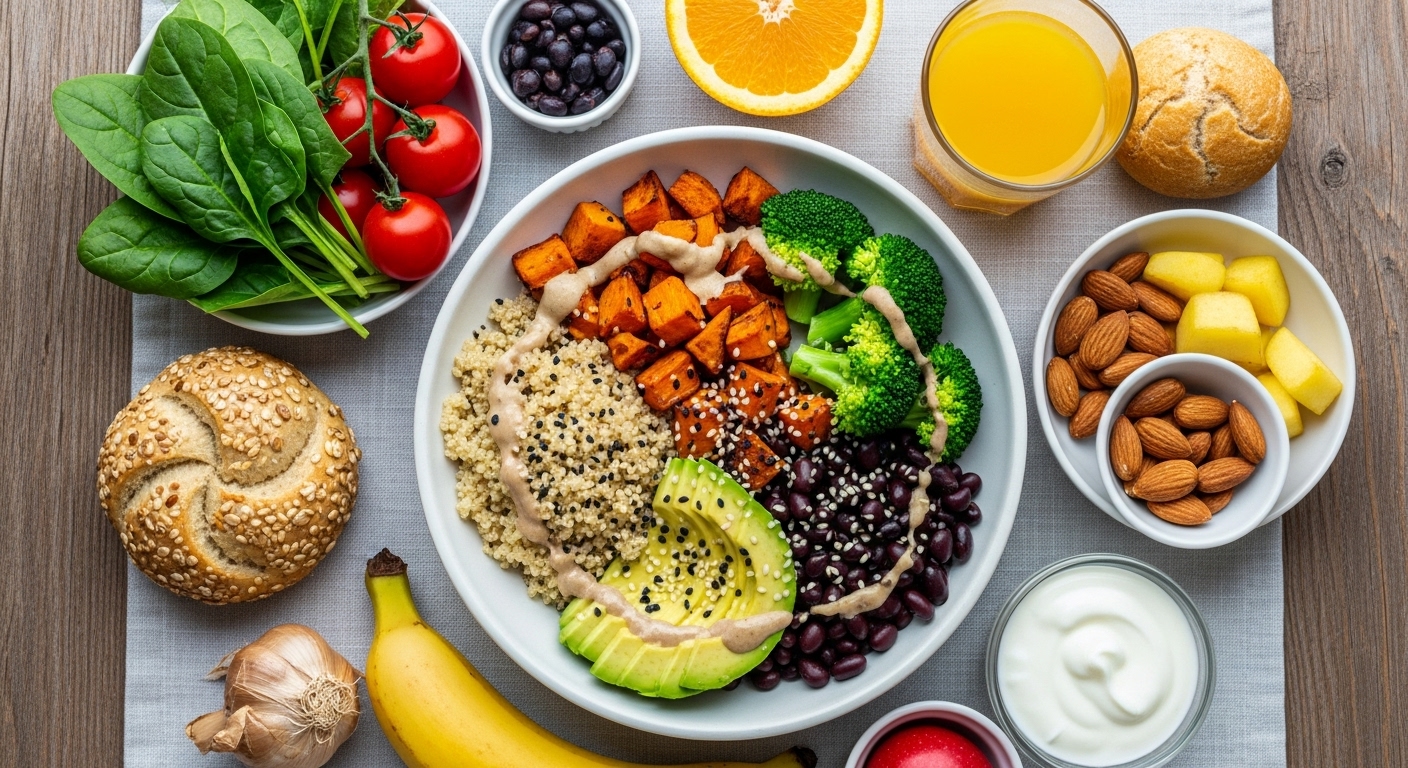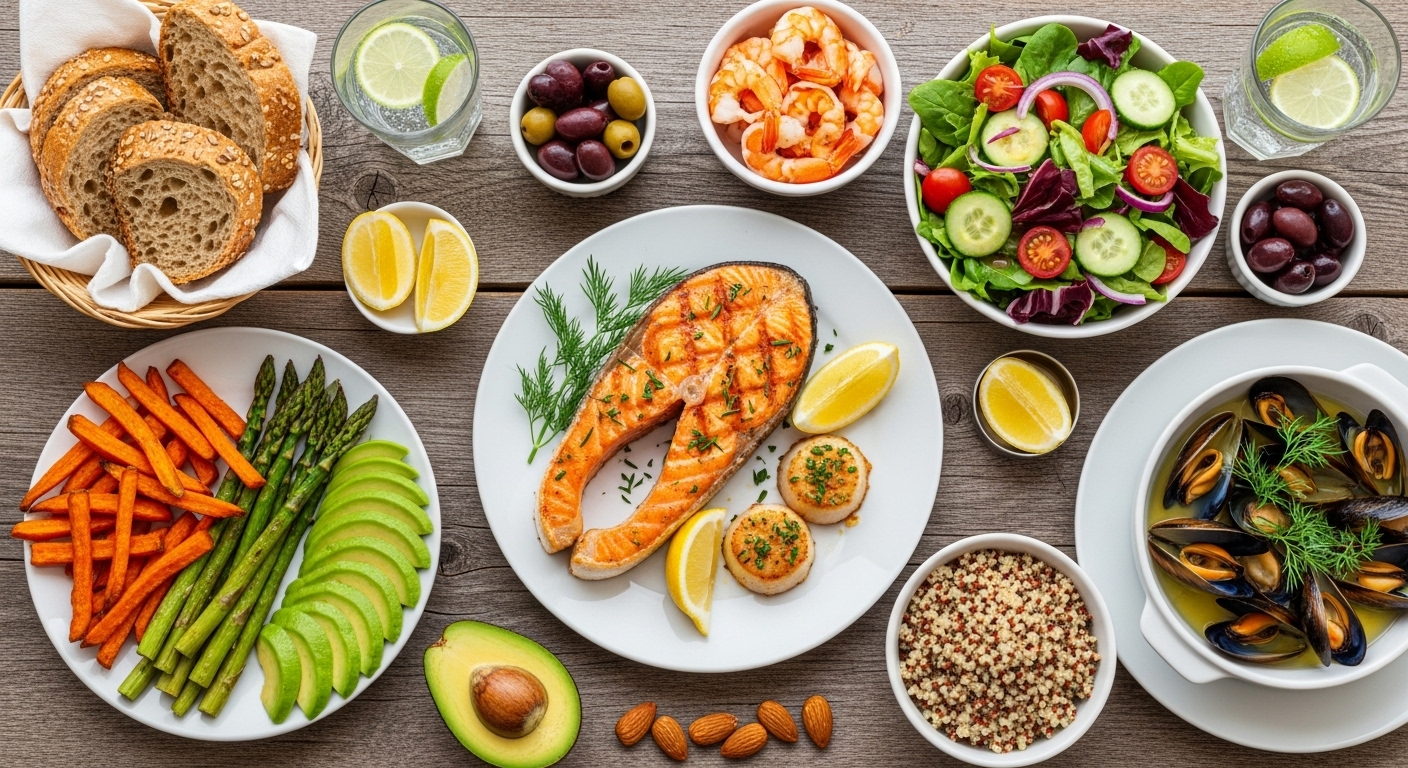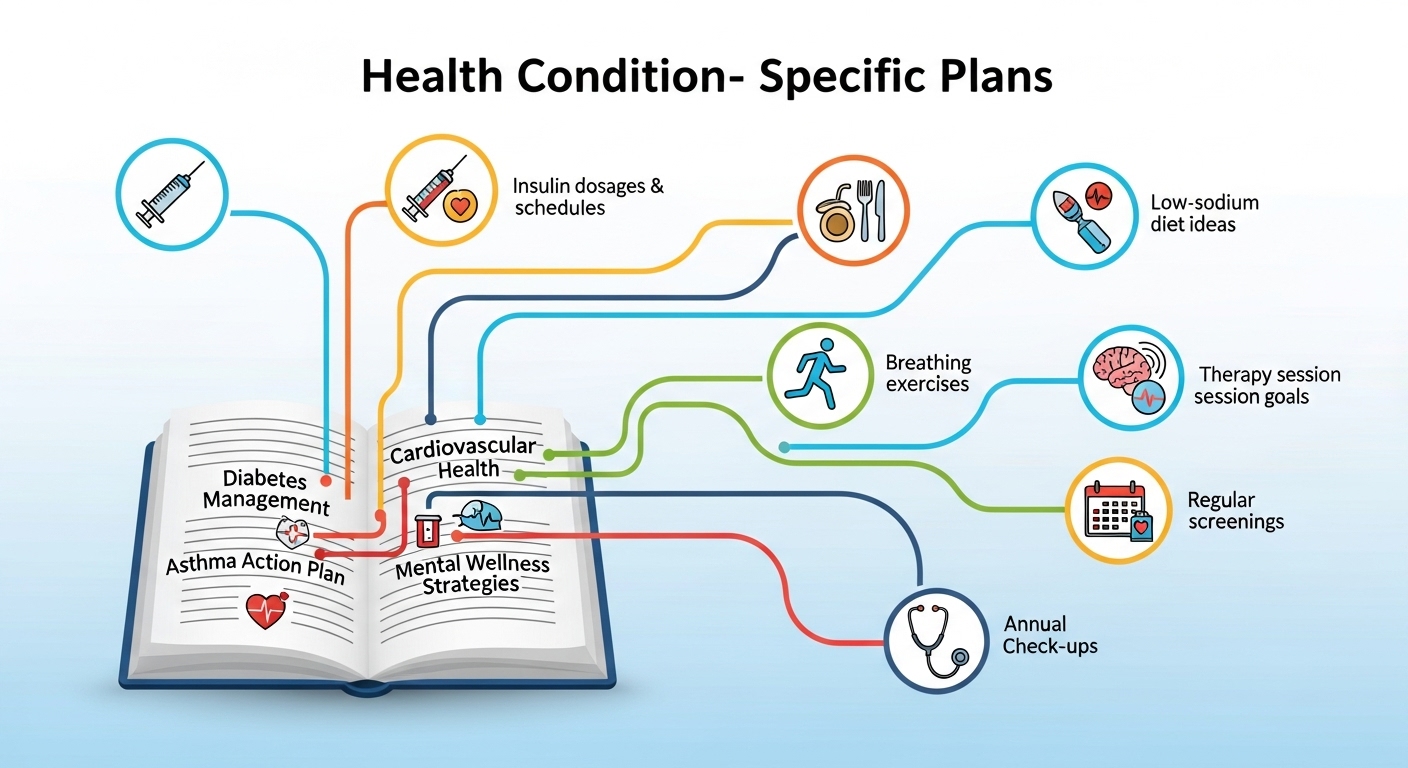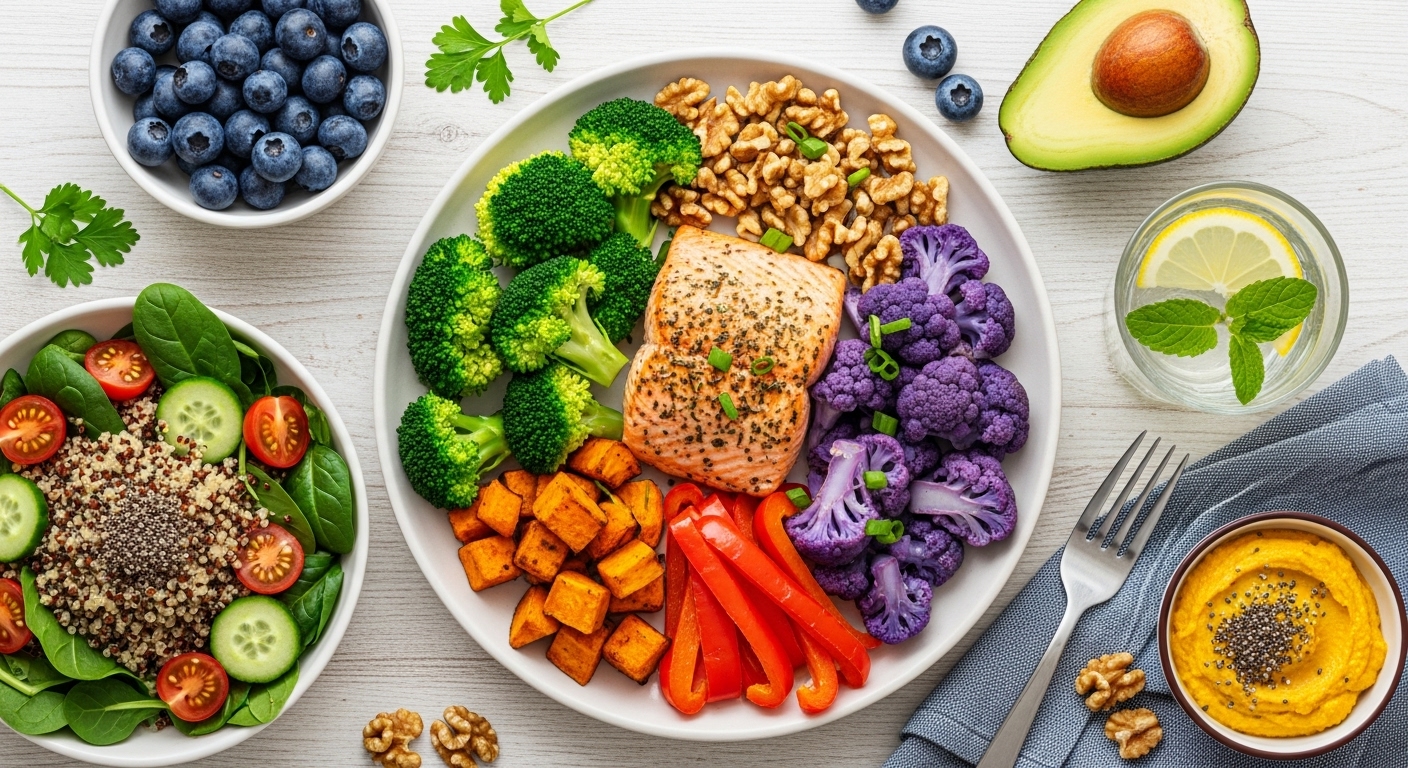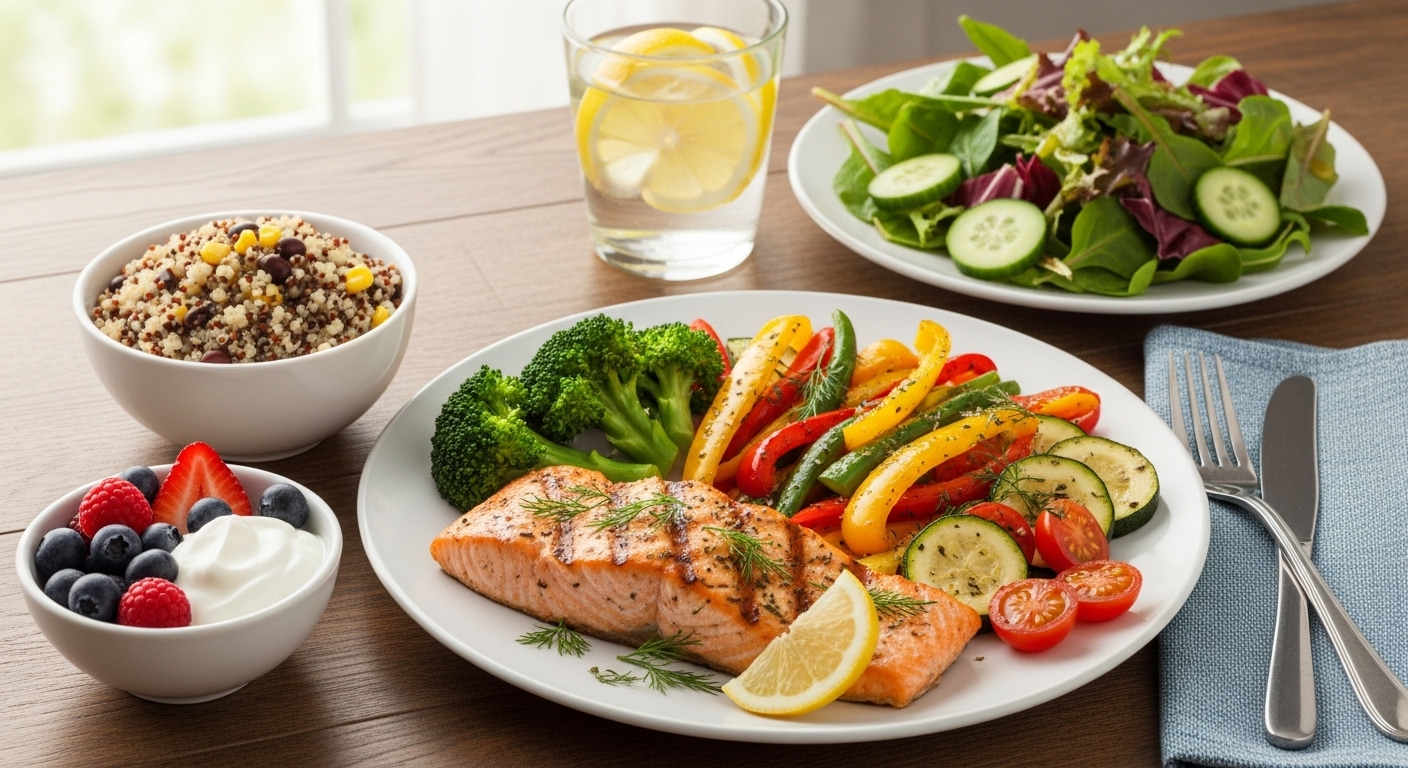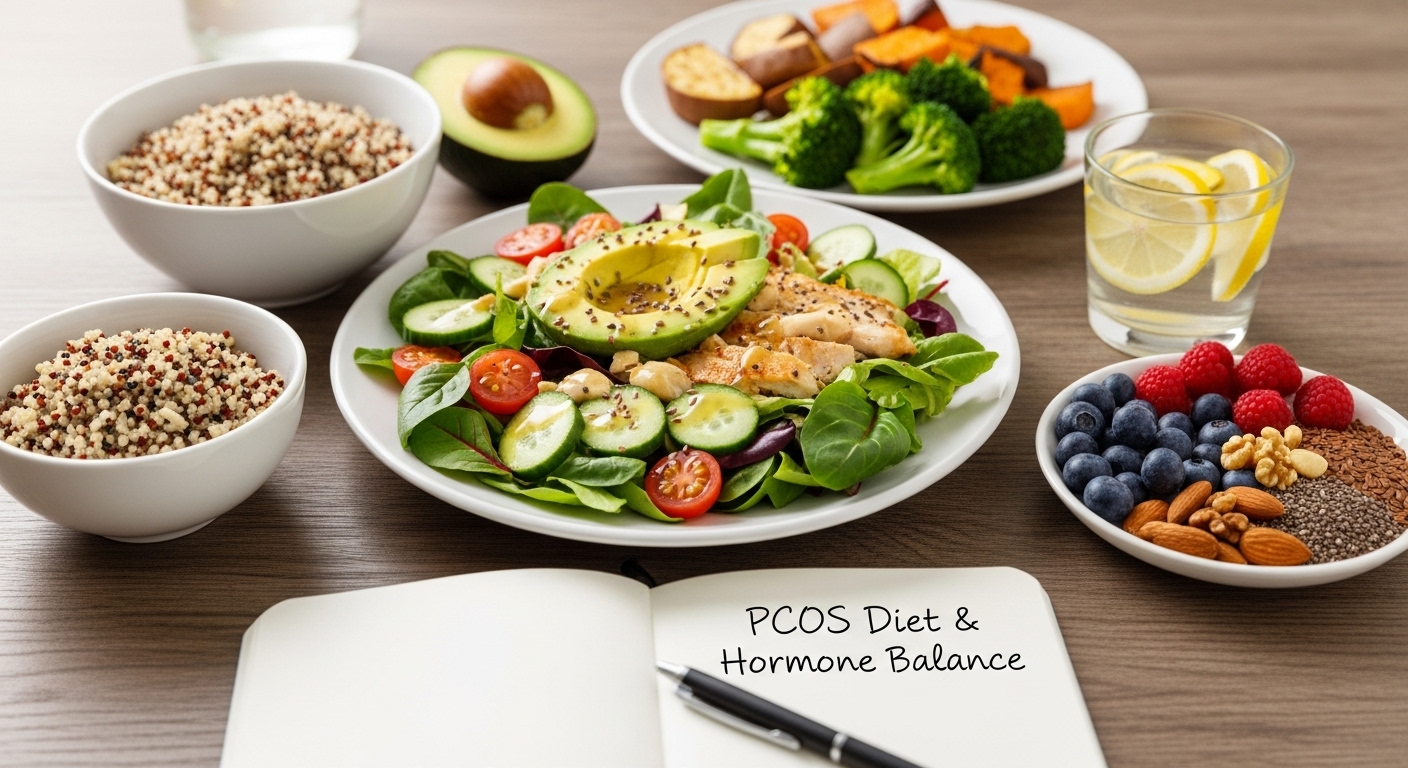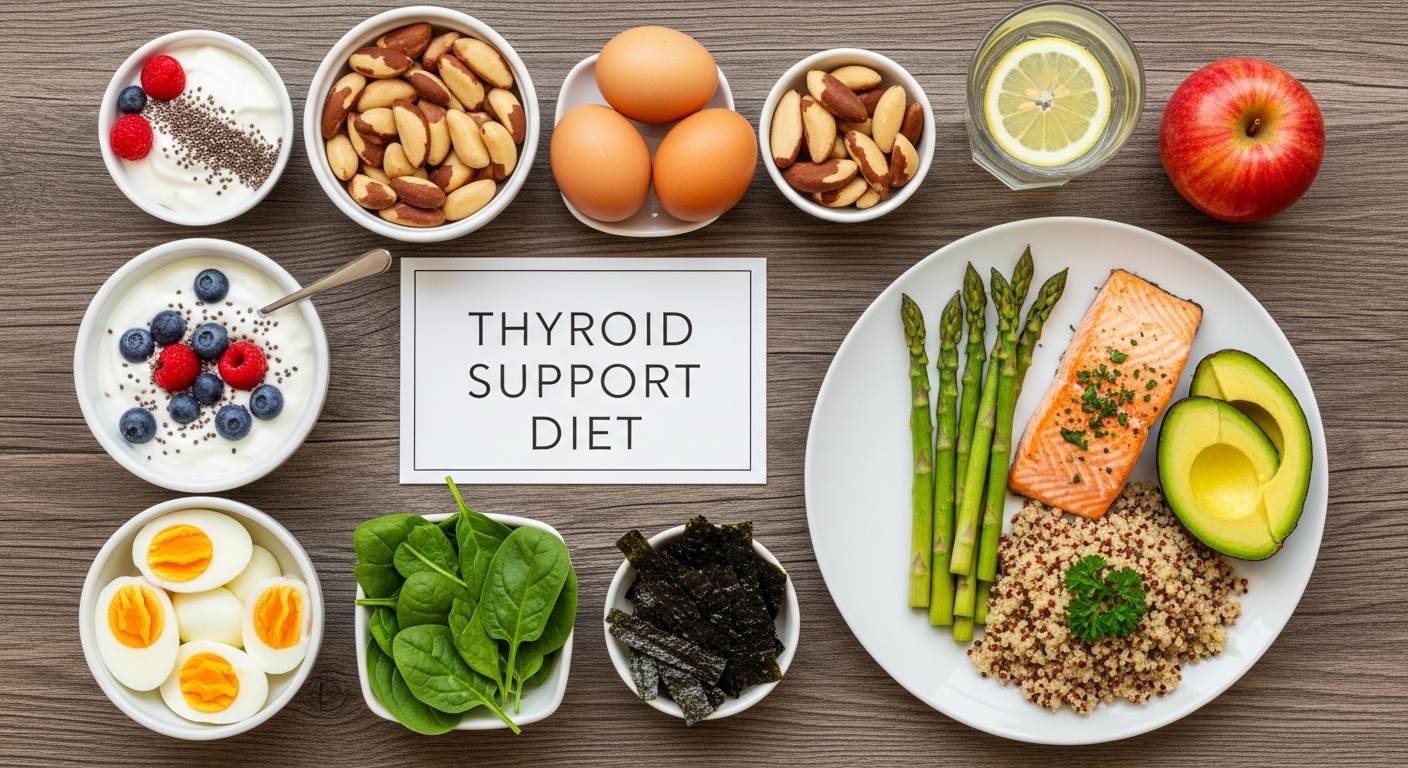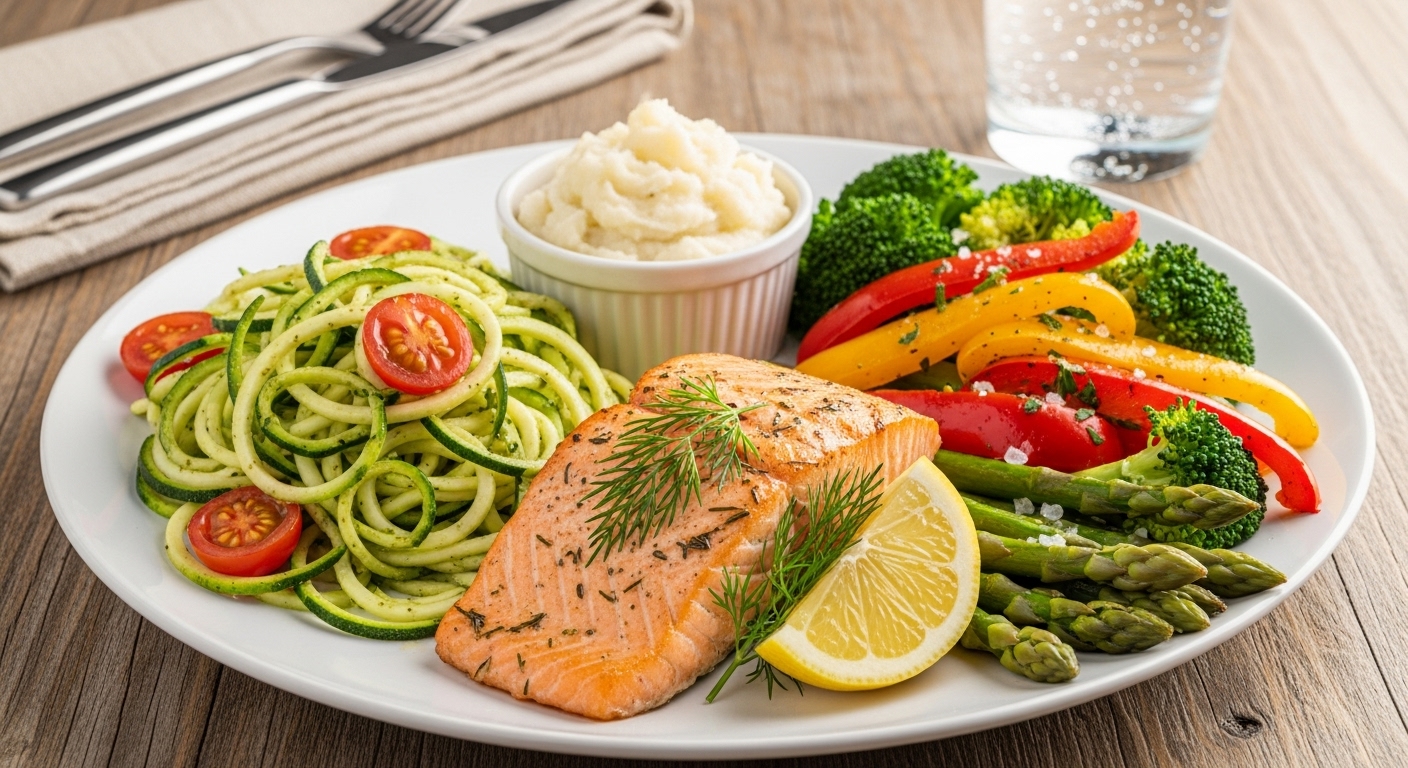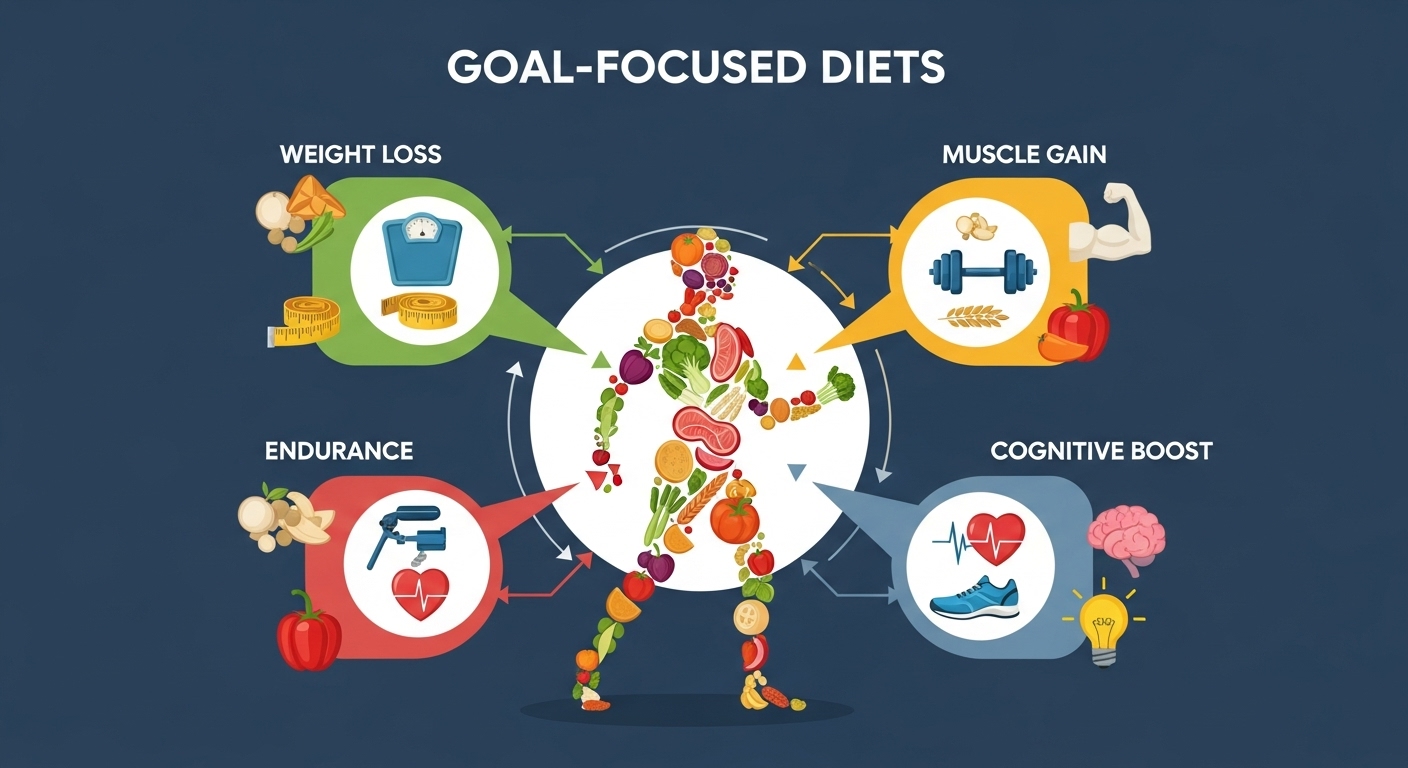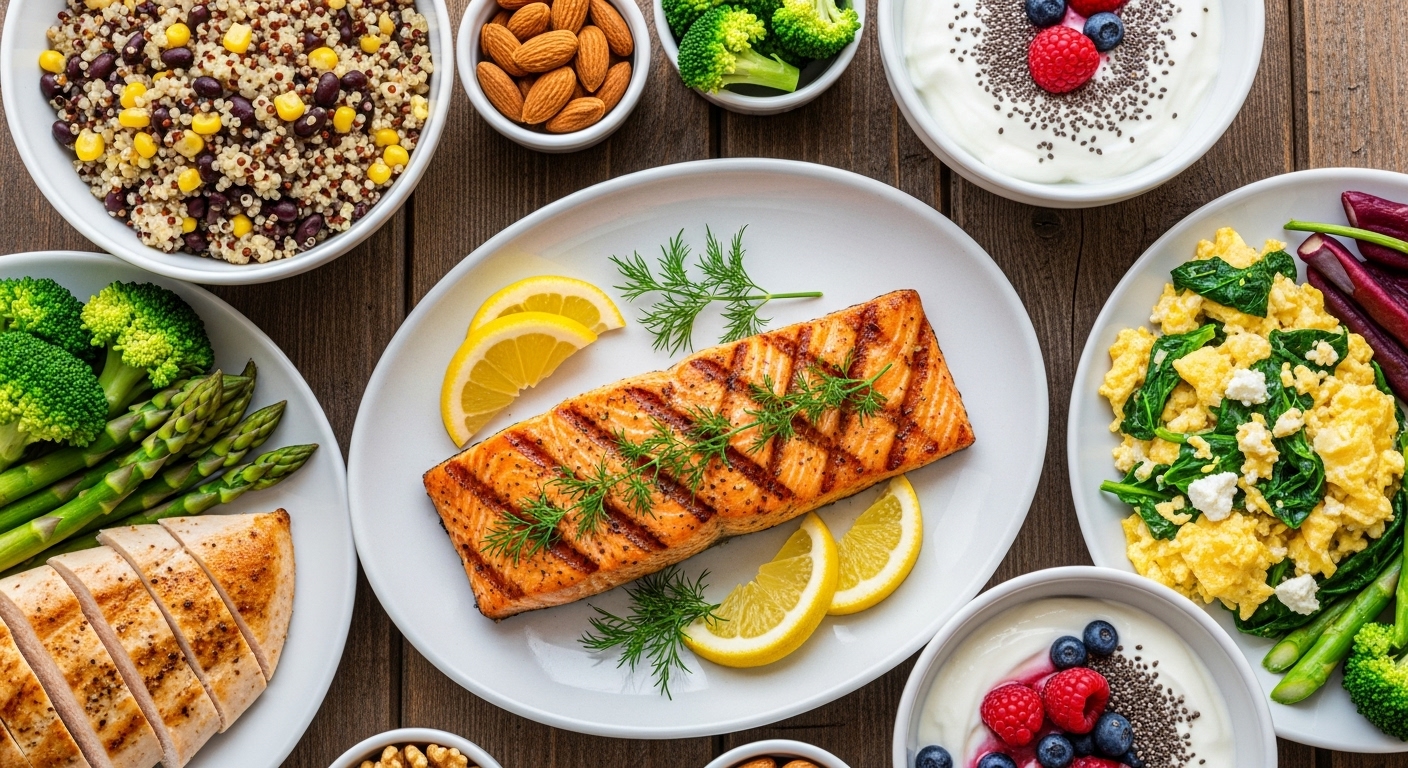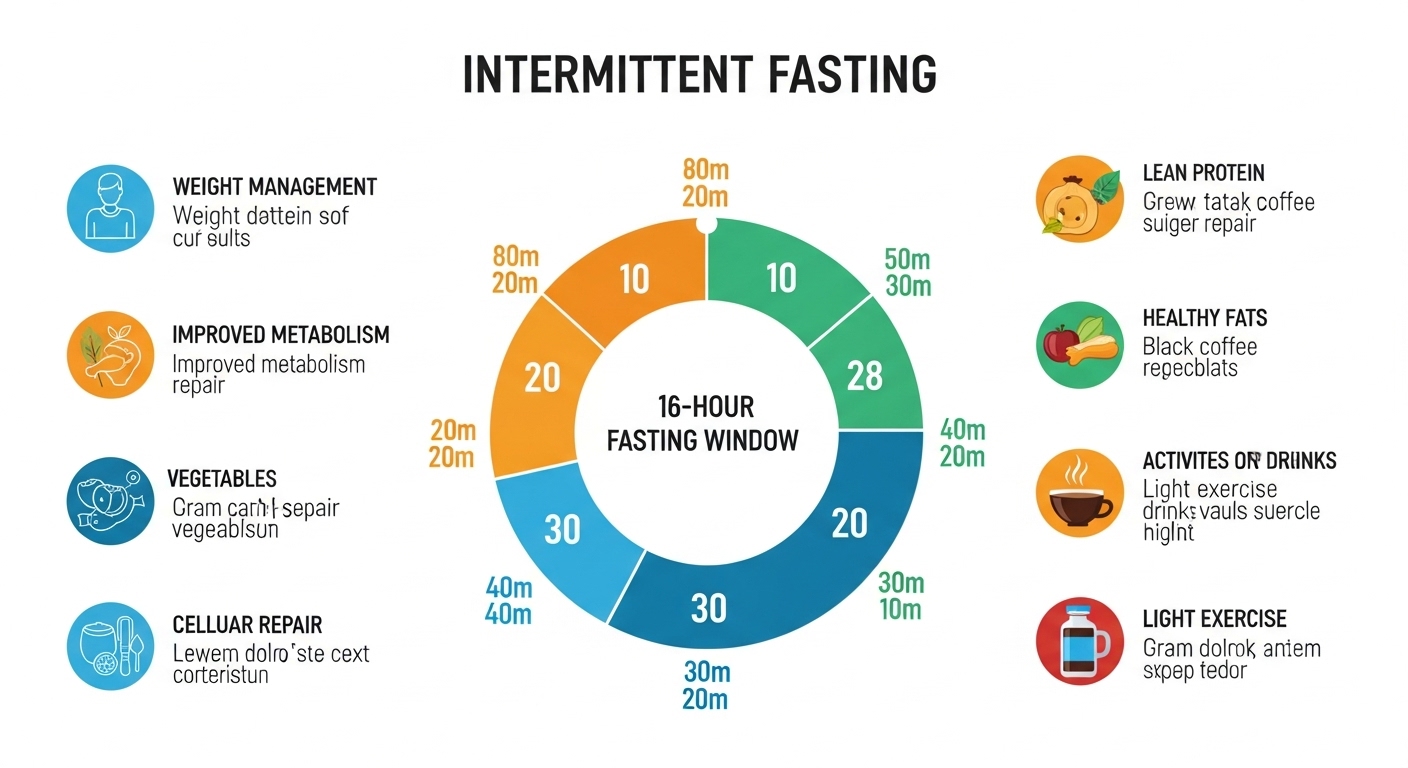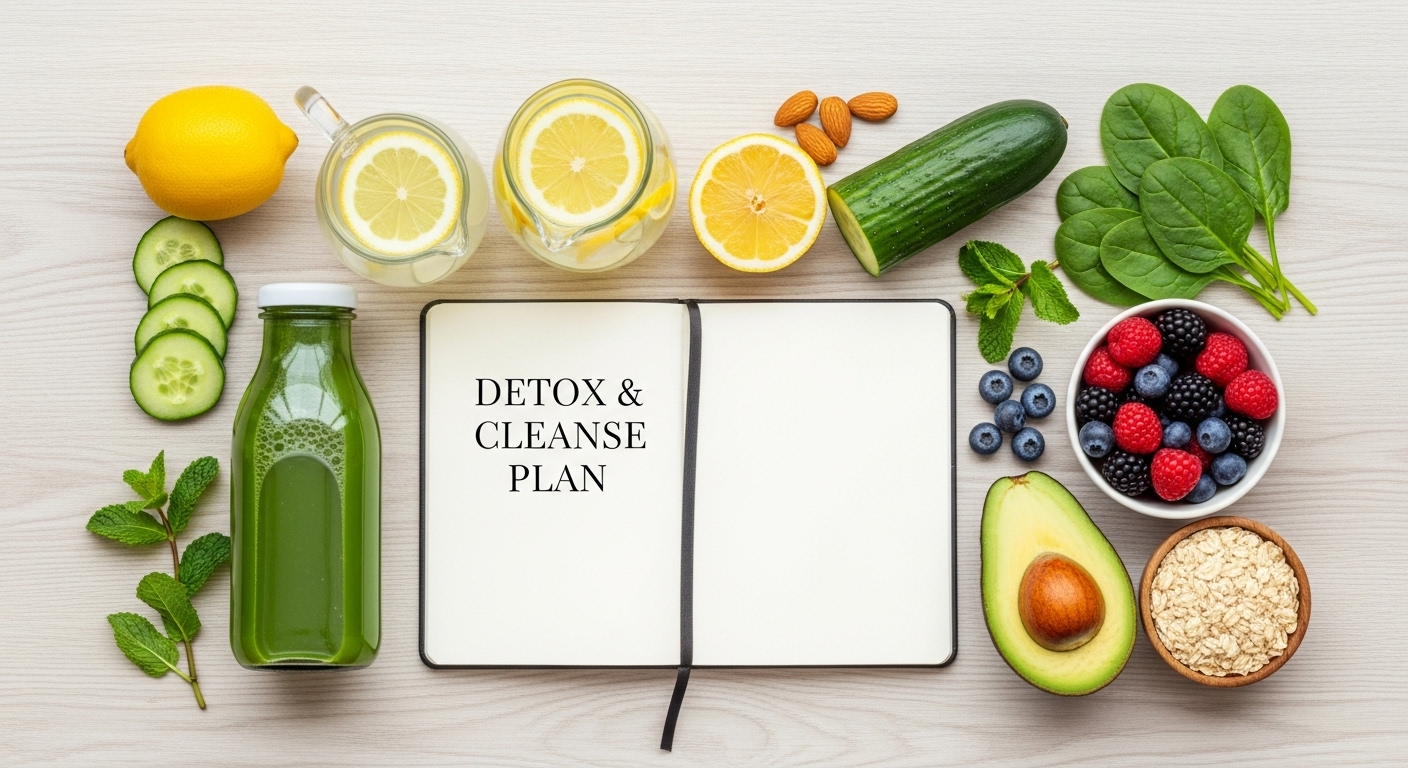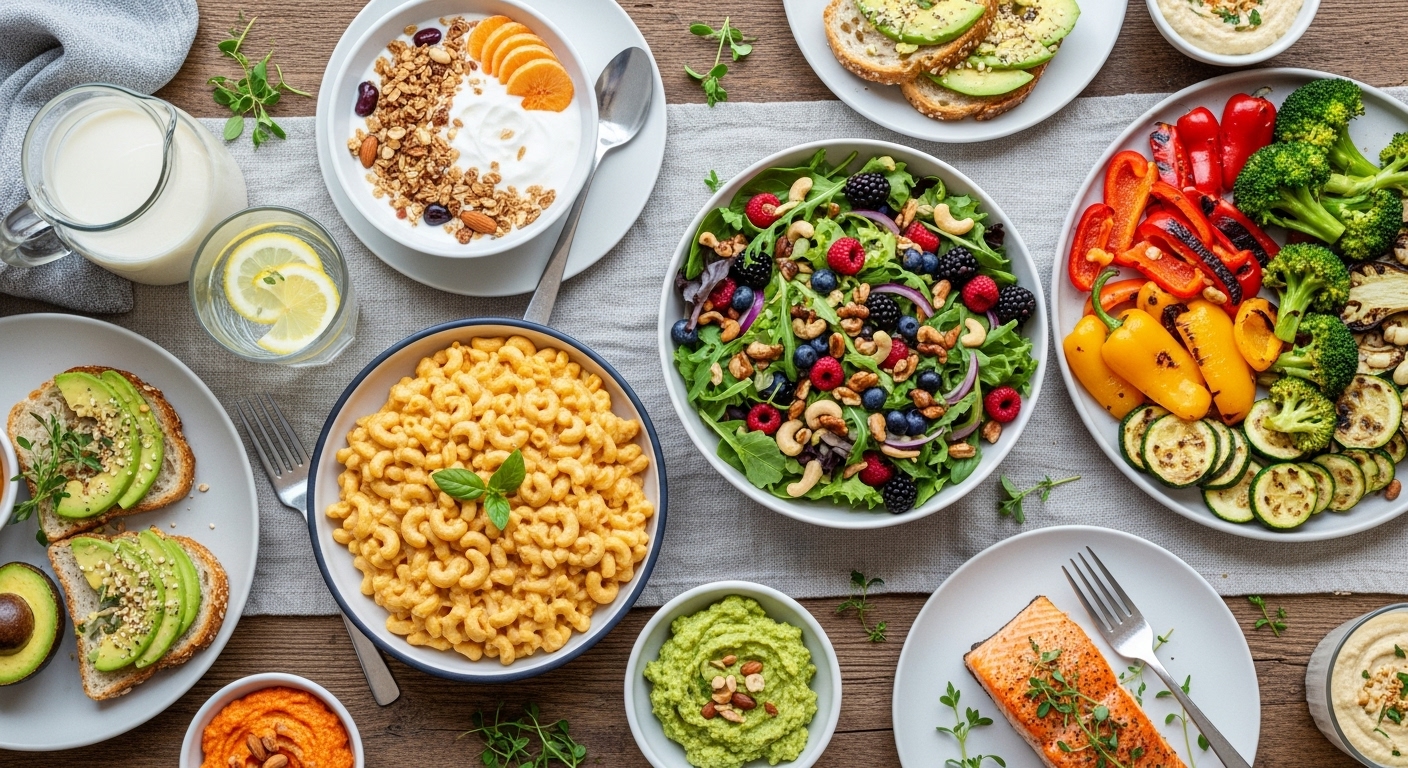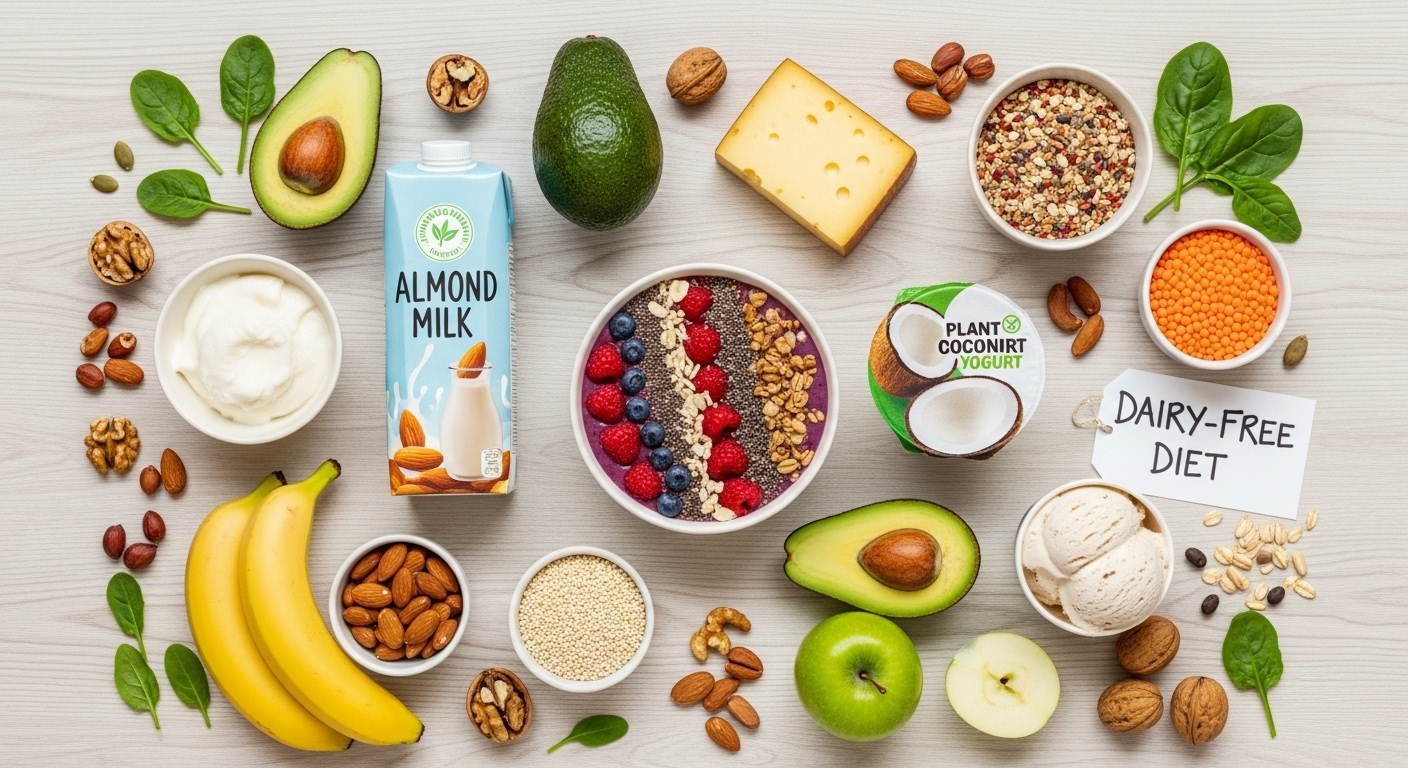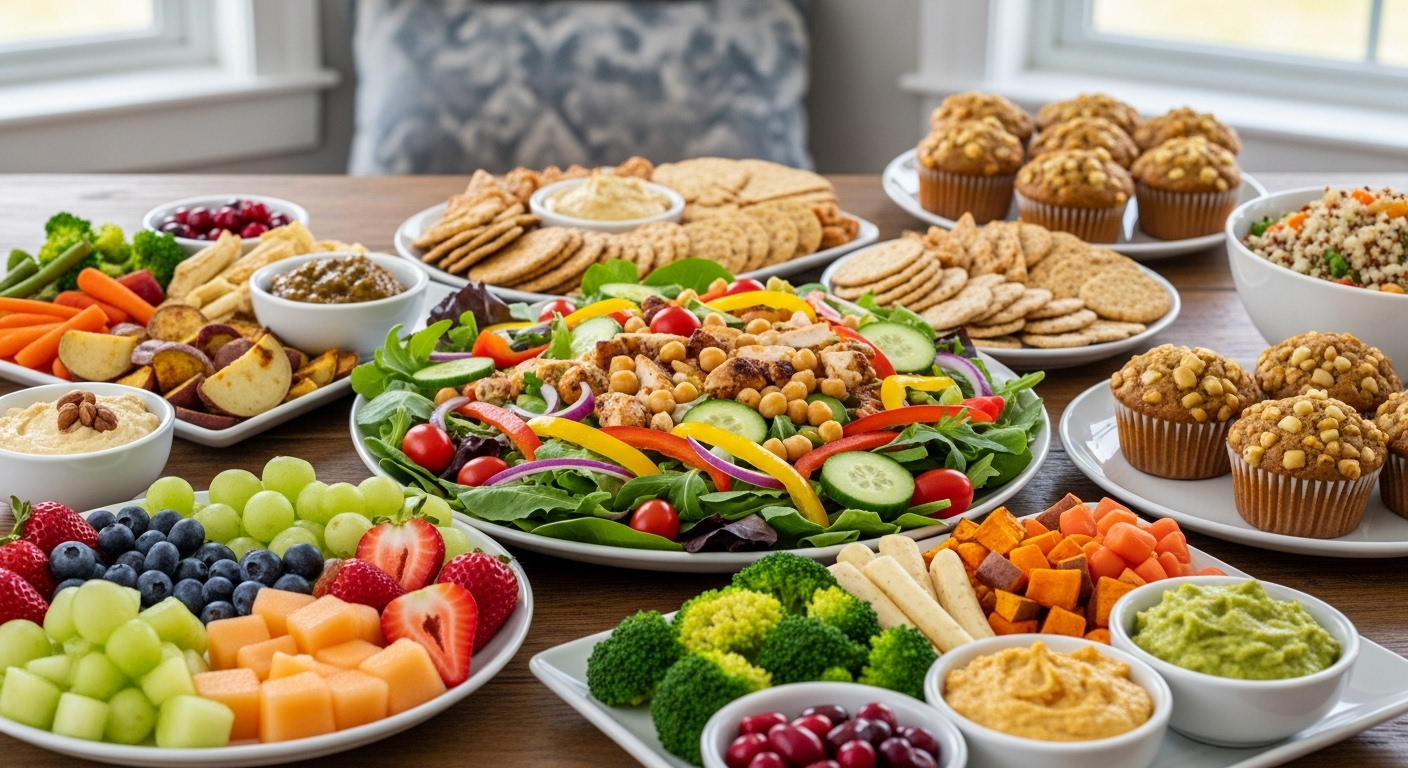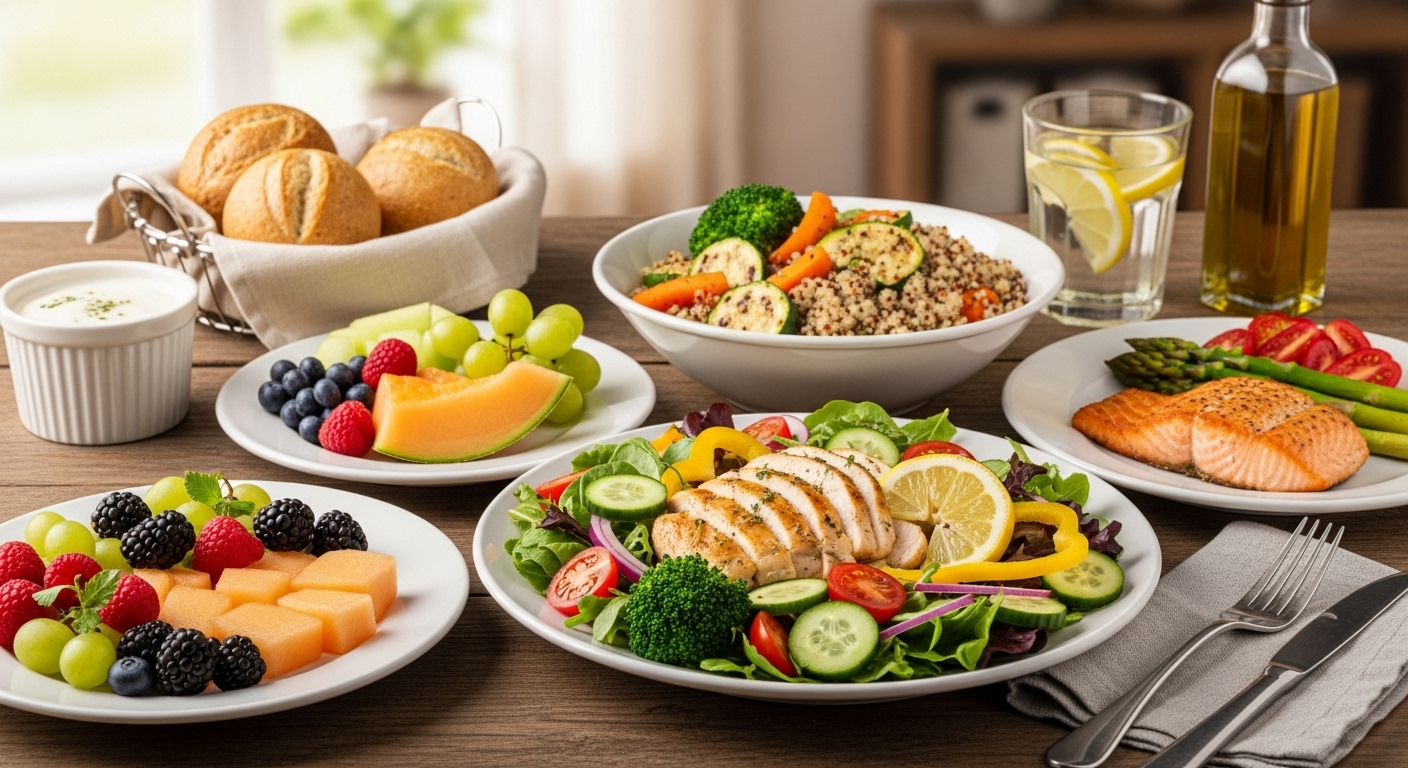Personalized Diet Plans 🍽️
Your nutrition, your way – tailored for your body and goals.
We create a fully customized meal plan based on your lifestyle, preferences, and health needs.
1️⃣ Information We Need from You
- Goal: Weight loss, muscle gain, maintenance, or medical support
- Basic Info: Age, Gender, Height, Weight
- Activity Level: Sedentary, lightly active, moderately active, very active
- Dietary Preferences: Veg, non-veg, vegan, keto, etc.
- Restrictions: Allergies, intolerances, or religious dietary rules
- Medical Conditions: Diabetes, hypertension, PCOS, etc.
- Meal Frequency: 3 big meals, 5–6 small meals, intermittent fasting, etc.
2️⃣ How We Structure Your Plan
- Daily Calorie Target – Calculated from your personal details
- Macronutrient Breakdown – Protein, carbs, fats
- Meal Plan Example – Breakfast, snacks, lunch, dinner
- Hydration & Lifestyle Tips – Water intake, exercise suggestions
- Flexibility Options – Swaps for each meal
3️⃣ Example Plan (Weight Loss – Veg)
Calories/day: ~1,800 kcal
Macros: Protein: 100g (22%), Carbs: 210g (47%), Fats: 60g (30%)
| Meal |
Example |
| Breakfast |
2 boiled eggs or tofu + 1 multigrain toast + green tea |
| Mid-Morning Snack |
1 apple + 10 almonds |
| Lunch |
Brown rice + dal + mixed veg + salad |
| Evening Snack |
Greek yogurt with berries |
| Dinner |
Grilled paneer/tofu + sautéed vegetables + quinoa |
Weight Management ⚖️
Weight management isn’t about crash diets or endless hours at the gym — it’s about finding a
healthy balance that works for your body and lifestyle.
It involves mindful eating, regular activity, and sustainable habits that improve your health and energy.
Nutrition
Fuel your body with whole, nutrient-rich foods that support health and energy.
Activity
Stay active to boost metabolism, build strength, and support your weight goals.
Mindset
Create a positive, realistic attitude that helps you stay motivated and consistent.
Step-by-Step Healthy Weight Management Plan
-
Know Your Numbers – Calculate your BMI and calorie needs.
-
Eat Smart – Prioritize veggies, lean proteins, and whole grains.
-
Stay Active – Aim for 150 mins of exercise weekly.
-
Hydrate – Drink 2–3 liters of water daily.
-
Mind Portions – Eat mindfully and avoid emotional snacking.
-
Rest & De-stress – Get 7–9 hrs sleep and manage stress.
-
Track Progress – Use a journal or app to adjust as needed.
Weight Loss Plan ⚖️
Smart & Sustainable – A balanced approach to healthy weight loss
1️⃣ Set Clear Goals
- 🎯 Define your target – Aim for 0.5–1 kg per week.
- 📏 Measure progress – Track weight, waist & clothing fit.
2️⃣ Nutrition – Eat for Fat Loss
- ⚖️ Calorie control – Moderate deficit (300–500 kcal/day).
- 🥚 High-protein meals – Eggs, chicken, tofu, beans, fish.
- 🥦 Fiber-rich foods – Vegetables, fruits, whole grains.
- 🥑 Healthy fats – Avocado, nuts, olive oil.
- 🚫 Avoid liquid calories – Sugary drinks & alcohol.
- 🕒 Meal timing – 3 meals + snack OR intermittent fasting.
3️⃣ Exercise – Burn More, Keep Muscle
- 🏃♂️ Cardio – 30–45 min, 4–5 days/week.
- 💪 Strength training – 2–3 times/week.
- 🚶♂️ Daily movement – Walk, stairs, stand more often.
4️⃣ Lifestyle Habits
- 😴 Sleep – 7–9 hours/night.
- 💧 Hydration – 2–3 liters/day.
- 🧘♀️ Stress control – Yoga, meditation, hobbies.
5️⃣ Tracking & Adjusting
- 📝 Track your food – Use an app or journal.
- 🔄 Reassess – Adjust every 2–3 weeks.
💡 Sample Daily Weight Loss Menu
| Meal |
Example |
| Breakfast | Oats with berries + boiled eggs |
| Snack | Greek yogurt + almonds |
| Lunch | Grilled chicken + quinoa + salad |
| Snack | Apple + peanut butter |
| Dinner | Baked fish + steamed vegetables |
Weight Gain / Muscle Building Plan
Build Strength, Gain Lean Muscle
1️⃣ Set a Clear Goal
- 🎯 Aim for steady gain – 0.25–0.5 kg/week to avoid excess fat gain.
- 💪 Focus on lean muscle – Build strength and size, not just scale weight.
2️⃣ Nutrition – Eat for Growth
- 🍽 Caloric surplus – 300–500 extra calories/day above maintenance.
- 🥚 Protein – 1.6–2.2g/kg body weight (eggs, chicken, fish, lean beef, tofu, dairy).
- 🌾 Carbs – Whole grains, oats, brown rice, sweet potatoes, fruits for energy.
- 🥑 Healthy fats – Avocados, nuts, seeds, olive oil.
- 🍴 Meal frequency – 4–6 nutrient-dense meals/snacks daily.
- 🏋️♂️ Post-workout – Protein shake + banana within 30–60 mins after training.
3️⃣ Training – Build Strength & Size
- 🏋️ Compound lifts – Squats, deadlifts, bench press, pull-ups, rows.
- 📈 Progressive overload – Gradually increase weight, reps, or sets.
- 🗓 Split routine – Push/Pull/Legs or Upper/Lower, 3–5 sessions/week.
- ✅ Form first – Proper technique prevents injury.
- ⏸ Rest days – Crucial for recovery and growth.
4️⃣ Lifestyle & Recovery
- 😴 Sleep – 7–9 hours/night for recovery and growth.
- 💧 Hydration – 2–3 liters/day.
- 🧘 Stress control – Manage stress to keep cortisol low.
5️⃣ Track & Adjust
- ⚖️ Weigh in weekly – Same time of day for accuracy.
- 📊 Adjust intake – If no gain in 2–3 weeks, add 150–200 calories/day.
- 🏆 Track strength gains – More strength = more muscle.
💪 Sample Daily Muscle-Building Menu
| Meal |
Example |
| Breakfast | Omelette with spinach + whole-grain toast + peanut butter |
| Snack | Protein shake + banana |
| Lunch | Grilled chicken + brown rice + broccoli + olive oil drizzle |
| Snack | Greek yogurt + oats + mixed nuts |
| Dinner | Salmon + sweet potato + asparagus |
| Evening Snack | Cottage cheese + berries |
Balanced Maintenance Plan – Stay Fit, Stay Energized
A balanced maintenance plan is for those who want to keep their current healthy weight, stay active, and maintain energy levels without strict dieting. Focuses on balanced nutrition, regular activity, and sustainable habits for life.
🌱 Core Principles
- ✅ Balanced Nutrition – Include carbs, proteins, and healthy fats in every meal.
- ✅ Consistency – Eat regular meals and avoid extreme diets.
- ✅ Active Lifestyle – Keep moving throughout the day, not just during workouts.
- ✅ Mindful Eating – Eat slowly and pay attention to hunger cues.
🍽 Daily Nutrition Goals
- Calories: Maintain your TDEE (Total Daily Energy Expenditure).
- Protein: 1.2–1.6g per kg body weight to support muscle health.
- Carbs: 45–55% of daily calories from whole grains, fruits, vegetables.
- Fats: 25–35% of daily calories from healthy sources like nuts, seeds, olive oil.
🏃 Exercise Recommendations
- 🏃♂️ Cardio: 150 minutes/week of moderate activity (brisk walking, cycling).
- 💪 Strength: 2–3 sessions/week to maintain muscle and bone strength.
- 🚶 Daily Activity: Take stairs, stretch breaks, short walks after meals.
🌞 Lifestyle Habits
- 💧 Hydration: 2–3 liters of water per day.
- 😴 Sleep: 7–9 hours/night for recovery and energy.
- 🧘 Stress Management: Meditation, hobbies, and relaxation techniques.
💡 Sample Daily Menu
- Breakfast: Greek yogurt + berries + chia seeds + honey drizzle.
- Snack: Handful of almonds + 1 banana.
- Lunch: Brown rice + grilled chicken or tofu + steamed vegetables + salad.
- Snack: Whole-grain toast + avocado + boiled egg.
- Dinner: Salmon or paneer + quinoa + sautéed greens.
Lifestyle-Based Diets
Eating for Your Life, Not Just a Goal
Lifestyle-based diets are about choosing an eating style that fits your daily routine, values, and preferences while supporting long-term health.
Unlike short-term “fad diets,” these approaches are sustainable and adaptable to different life stages, activity levels, and cultural food choices.
1️⃣ Mediterranean Diet – Heart-Healthy & Balanced
- 🥗 Focus: Fresh vegetables, fruits, whole grains, nuts, olive oil, fish.
- ❤️ Benefits: Heart health, longevity, reduced inflammation.
- 👌 Perfect for: People who enjoy fresh, seasonal foods and moderate wine intake.
2️⃣ Plant-Based Diet – Powered by Plants
- 🌱 Focus: Vegetables, fruits, legumes, nuts, seeds, whole grains; minimal or no animal products.
- 💚 Benefits: Lower cholesterol, improved digestion, reduced environmental impact.
- 👌 Perfect for: Vegetarians, vegans, or anyone aiming to reduce animal-based foods.
3️⃣ Low-Carb / Keto Diet – Fat-Fueled Energy
- 🥓 Focus: High healthy fats, moderate protein, low carbohydrates.
- ⚡ Benefits: Can support fat loss, stabilize blood sugar, reduce cravings.
- 👌 Perfect for: People with insulin resistance, or those who feel better with fewer carbs.
4️⃣ Paleo Diet – Back to Basics
- 🥩 Focus: Lean meats, fish, vegetables, fruits, nuts, seeds; no processed foods or grains.
- 🌿 Benefits: Reduced processed food intake, improved nutrient quality.
- 👌 Perfect for: Those who prefer simple, whole-food eating without processed carbs.
5️⃣ Intermittent Fasting – Eating in Time Windows
- ⏳ Focus: Alternating eating and fasting periods (e.g., 16:8, 18:6).
- 🩺 Benefits: Can help control calories, improve insulin sensitivity, support weight loss.
- 👌 Perfect for: People who don’t enjoy frequent meals and prefer structured eating times.
6️⃣ Flexitarian Diet – Mostly Plants, Some Animal Foods
- 🥦 Focus: Primarily plant-based but includes moderate amounts of meat, poultry, or fish.
- ⚖️ Benefits: Balanced nutrition, easier to follow than strict vegetarian or vegan diets.
- 👌 Perfect for: People who want a flexible approach without giving up meat entirely.
🌟 Tip: The best lifestyle diet is the one you can enjoy for years, not just for weeks.
Choose an approach that supports your health goals, food enjoyment, and cultural preferences.
Keto Diet – Low-Carb, High-Fat Lifestyle
The Keto Diet is a low-carb, high-fat eating plan that shifts your body into a state of ketosis — where it burns fat for fuel instead of carbohydrates.
It’s known for supporting weight loss, stabilizing blood sugar, and providing sustained energy throughout the day.
📌 Core Principles
- Very Low Carbs – Usually 20–50g net carbs per day.
- High Fat – 65–75% of daily calories from healthy fats.
- Moderate Protein – 20–30% of daily calories from quality protein sources.
- No Sugar & Grains – Avoid bread, pasta, rice, sweets, and sugary drinks.
⚖ Macronutrient Breakdown
- Carbs: 5–10% of total calories
- Protein: 20–30% of total calories
- Fat: 65–75% of total calories
🥓 Foods to Eat
- Meat: Chicken, beef, pork, lamb.
- Fish & Seafood: Salmon, mackerel, sardines, shrimp.
- Eggs: Free-range or omega-3 enriched.
- Healthy Fats: Avocado, olive oil, coconut oil, nuts, seeds.
- Low-Carb Vegetables: Leafy greens, broccoli, cauliflower, zucchini.
- Dairy: Cheese, heavy cream, unsweetened yogurt.
🚫 Foods to Avoid
- Sugar: Sweets, candy, soft drinks, pastries.
- Grains: Wheat, rice, oats, corn, barley.
- High-Carb Fruits: Bananas, grapes, mangoes.
- Starchy Vegetables: Potatoes, sweet potatoes, peas, corn.
💪 Benefits
- Supports fat loss and appetite control.
- May improve insulin sensitivity.
- Provides stable energy without sugar crashes.
- May enhance mental clarity for some people.
⚠ Potential Challenges
- “Keto flu” during the first week (fatigue, headache, brain fog).
- May require electrolyte supplementation.
- Not suitable for everyone — consult a doctor if you have medical conditions.
💡 Sample Daily Menu
- Breakfast: Scrambled eggs cooked in butter + spinach + avocado slices.
- Snack: Handful of walnuts + cheese cubes.
- Lunch: Grilled salmon + cauliflower mash + sautéed zucchini.
- Snack: Celery sticks with almond butter.
- Dinner: Roasted chicken thighs + broccoli with olive oil drizzle.
Mediterranean Diet – Heart-Healthy & Balanced
Fresh • Flavorful • Nutrient-Dense
The Mediterranean Diet is inspired by the traditional eating patterns of countries bordering the
Mediterranean Sea. It emphasizes whole, minimally processed foods, healthy fats, and a balanced
lifestyle — making it one of the most researched and health-promoting diets in the world.
🌟 Key Benefits
- ❤️ Heart health – Supports healthy cholesterol and blood pressure.
- ⚖️ Balanced nutrition – Rich in vitamins, minerals, and antioxidants.
- 🧠 Brain support – Linked to improved cognitive function.
- 💪 Longevity – Associated with reduced risk of chronic diseases.
🥗 Mediterranean Basics – What to Eat & Limit
✅ Eat More:
- 🥦 Vegetables & fruits
- 🐟 Fatty fish (salmon, sardines, tuna)
- 🥜 Nuts & seeds
- 🍞 Whole grains (oats, barley, brown rice)
- 🫒 Olive oil as main fat source
- 🧄 Fresh herbs & spices
❌ Limit:
- 🍖 Red meat (limit to a few times per month)
- 🍰 Refined sugars & sweets
- 🧂 Excess salt
- 🥤 Sugary beverages
- 🍞 Refined white bread & pasta
🌿 Lifestyle Tips
- 🍷 Enjoy wine in moderation (optional).
- 👨👩👧👦 Share meals with family and friends.
- 🚶♀️ Stay active daily through walking and other activities.
🍽 Sample Daily Mediterranean Menu
| Meal |
Example |
| Breakfast |
Greek yogurt topped with berries + drizzle of honey + walnuts |
| Snack |
Fresh fruit + handful of almonds |
| Lunch |
Grilled salmon + quinoa salad with olive oil dressing |
| Snack |
Carrot sticks + hummus |
| Dinner |
Whole wheat pasta with vegetables + tomato-olive sauce + side salad |
💡 Tip: Make olive oil your primary cooking fat, and build your plate around vegetables, whole grains, and fish. Enjoy meals slowly and in good company for both physical and mental health benefits.
Vegan / Plant-Based Diet – Powered by Plants
100% Plant-Powered • Nutrient-Rich • Sustainable
The Vegan / Plant-Based Diet focuses entirely on foods derived from plants, avoiding all animal products.
It’s rich in fiber, antioxidants, and phytonutrients, making it beneficial for heart health, digestion, and
the environment. When balanced well, it can provide all the essential nutrients your body needs.
🌟 Key Benefits
- ❤️ Heart health – Low in saturated fats, high in fiber.
- 🌱 Lower inflammation – Antioxidant-rich plant foods.
- 🌍 Eco-friendly – Lower environmental footprint.
- ⚖️ Healthy weight – Naturally lower-calorie, nutrient-dense meals.
🥦 Plant-Based Basics – What to Eat & Avoid
✅ Eat More:
- 🥦 Vegetables & leafy greens
- 🍎 Fresh fruits
- 🌾 Whole grains (oats, quinoa, brown rice)
- 🌱 Legumes (beans, lentils, chickpeas)
- 🥜 Nuts & seeds
- 🥑 Healthy fats (avocado, olive oil, flaxseed)
❌ Avoid:
- 🍖 All animal products (meat, poultry, fish)
- 🥚 Eggs
- 🥛 Dairy (milk, cheese, butter)
- 🍯 Honey (optional for strict vegans)
- 🍩 Processed junk food high in sugar & trans fats
💊 Nutrients to Watch
- 💪 Protein – Lentils, chickpeas, tofu, tempeh, edamame.
- 🌞 Vitamin B12 – Fortified foods or supplements.
- 🦴 Calcium – Fortified plant milks, leafy greens.
- 🩸 Iron – Lentils, beans, pumpkin seeds (pair with vitamin C foods for better absorption).
- 🧠 Omega-3s – Flaxseed, chia seeds, walnuts.
🍽 Sample Daily Vegan Menu
| Meal |
Example |
| Breakfast |
Overnight oats with almond milk, chia seeds, and berries |
| Snack |
Apple slices with peanut butter |
| Lunch |
Quinoa salad with chickpeas, spinach, cucumber, olive oil dressing |
| Snack |
Hummus with carrot and celery sticks |
| Dinner |
Stir-fried tofu with broccoli, bell peppers, and brown rice |
💡 Tip: Include a variety of plant-based protein sources daily, and consider fortified foods or supplements for vitamin B12.
Vegetarian Diet – Balanced Plant-Based Eating
Nourishing • Wholesome • Flexible
The Vegetarian Diet focuses on plant-based foods while allowing dairy products and eggs.
It’s a flexible and nutrient-rich eating style that supports heart health, healthy weight,
and long-term wellness without relying on meat or fish.
🌟 Key Benefits
- ❤️ Heart health – Low in saturated fats, high in antioxidants.
- 🥗 Rich nutrition – High in vitamins, minerals, and fiber.
- ⚖️ Weight balance – Can support healthy weight management.
- 🌱 Eco-friendly – Reduces environmental impact compared to meat-based diets.
🥦 Vegetarian Basics – What to Eat & Limit
✅ Eat More:
- 🥦 Vegetables & leafy greens
- 🍎 Fresh fruits
- 🌾 Whole grains (brown rice, oats, quinoa)
- 🌱 Legumes (beans, lentils, chickpeas)
- 🥜 Nuts & seeds
- 🥛 Dairy products (milk, cheese, yogurt)
- 🥚 Eggs (if ovo-vegetarian)
❌ Limit:
- 🍖 Meat, poultry, and fish
- 🍔 Processed vegetarian junk foods
- 🍩 Excess sugar and refined carbs
- 🥤 Sugary drinks
- 🧂 High-sodium packaged foods
💊 Nutrients to Watch
- 💪 Protein – Eggs, dairy, legumes, tofu, quinoa.
- 🩸 Iron – Lentils, beans, spinach (pair with vitamin C foods).
- 🌞 Vitamin B12 – Dairy, eggs, fortified cereals.
- 🦴 Calcium – Dairy products, fortified plant milks, leafy greens.
- 🧠 Omega-3s – Flaxseed, chia seeds, walnuts.
🍽 Sample Daily Vegetarian Menu
| Meal |
Example |
| Breakfast |
Vegetable omelette + whole-grain toast + fresh fruit |
| Snack |
Greek yogurt with honey and walnuts |
| Lunch |
Brown rice + dal + sautéed vegetables + salad |
| Snack |
Hummus with carrot sticks |
| Dinner |
Grilled paneer with quinoa and roasted vegetables |
💡 Tip: Focus on diverse plant foods, include dairy and eggs (if preferred), and plan meals for balanced nutrition.
Pescatarian Diet – The Best of Land & Sea
Seafood • Plant Power • Balanced Nutrition
The Pescatarian Diet combines a vegetarian base with the inclusion of fish and seafood.
It’s rich in omega-3 fatty acids, lean proteins, and antioxidants, supporting heart and brain health
while offering more variety than a fully vegetarian or vegan diet.
🌟 Key Benefits
- ❤️ Heart health – Omega-3s from fish reduce cardiovascular risk.
- 🧠 Brain support – DHA & EPA promote cognitive function.
- ⚖️ Weight management – Lean protein supports satiety and muscle.
- 🌱 Balanced diet – Combines plant-based nutrients with healthy seafood fats.
🐟 Pescatarian Basics – What to Eat & Limit
✅ Eat More:
- 🐟 Fish & seafood (salmon, tuna, sardines, shrimp)
- 🥦 Vegetables & leafy greens
- 🍎 Fresh fruits
- 🌾 Whole grains (quinoa, oats, brown rice)
- 🌱 Legumes (beans, lentils, chickpeas)
- 🥜 Nuts & seeds
- 🥛 Dairy products & eggs (optional)
❌ Limit:
- 🍖 Red & processed meats
- 🍔 Deep-fried seafood
- 🍩 High-sugar processed snacks
- 🥤 Sugary drinks
- 🧂 Excess salt in canned seafood
💊 Nutrients to Watch
- 💪 Protein – Fish, seafood, eggs, dairy, legumes.
- 🧠 Omega-3s – Salmon, sardines, flaxseeds, chia seeds.
- 🩸 Iron – Lentils, spinach, fortified cereals.
- 🌞 Vitamin D – Fatty fish, fortified dairy or plant milk.
- 🦴 Calcium – Dairy, fortified plant milks, leafy greens.
🍽 Sample Daily Pescatarian Menu
| Meal |
Example |
| Breakfast |
Greek yogurt with berries & chia seeds |
| Snack |
Apple slices with almond butter |
| Lunch |
Grilled salmon + quinoa + roasted vegetables |
| Snack |
Hummus with cucumber sticks |
| Dinner |
Shrimp stir-fry with broccoli & brown rice |
💡 Tip: Choose sustainably sourced seafood to protect ocean health and reduce exposure to mercury.
Health Condition–Specific Plans
Targeted nutrition to manage and support specific health needs.
These diet plans are designed to support individuals with specific medical conditions.
They focus on foods that help manage symptoms, improve health outcomes, and promote
overall well-being — while avoiding foods that may worsen the condition.
Diabetes-Friendly Diet – Balance Your Blood Sugar
Focuses on keeping blood glucose levels stable with balanced meals and portion control.
- ✅ High-fiber foods (oats, legumes, vegetables)
- ✅ Lean protein (fish, chicken, tofu)
- ✅ Healthy fats (olive oil, nuts)
- ❌ Avoid refined sugars and processed carbs
Heart-Healthy Diet – Nourish Your Cardiovascular System
Designed to reduce cholesterol, lower blood pressure, and support heart health.
- ✅ Omega-3-rich fish (salmon, sardines)
- ✅ Fruits & vegetables of all colors
- ✅ Whole grains (brown rice, quinoa, oats)
- ❌ Limit saturated fats, trans fats, and excess salt
PCOS Diet – Support Hormone Balance
Helps manage insulin resistance, reduce inflammation, and balance hormones.
- ✅ Lean protein and high-fiber carbs
- ✅ Anti-inflammatory foods (berries, leafy greens, fatty fish)
- ✅ Healthy fats (avocados, olive oil)
- ❌ Avoid sugary drinks and refined carbs
Thyroid Support Diet – Boost Metabolic Health
Provides nutrients that support healthy thyroid function and hormone production.
- ✅ Iodine-rich foods (seaweed, iodized salt)
- ✅ Selenium sources (Brazil nuts, tuna, eggs)
- ✅ Zinc-rich foods (pumpkin seeds, chickpeas)
- ❌ Avoid excess soy and ultra-processed foods
Anti-Inflammatory Diet – Calm Your Body
Reduces chronic inflammation that may contribute to disease and discomfort.
- ✅ Fruits, vegetables, whole grains
- ✅ Omega-3 fatty acids (salmon, flaxseeds)
- ✅ Spices like turmeric and ginger
- ❌ Minimize processed foods and excessive alcohol
💡 Tip: Always consult your healthcare provider or a registered dietitian before starting a new diet, especially if you have a medical condition.
Diabetes-Friendly Diet – Balance Your Blood Sugar
Smart eating choices to manage blood sugar and improve overall health.
A Diabetes-Friendly Diet focuses on keeping blood glucose levels steady through balanced meals, portion control, and nutrient-rich foods.
It supports energy levels, prevents blood sugar spikes, and reduces the risk of diabetes-related complications.
🌟 Key Benefits
- 💉 Stabilizes blood sugar – Prevents rapid spikes and crashes.
- ⚖️ Supports healthy weight – Balanced calorie intake aids weight control.
- ❤️ Protects heart health – Reduces risk of cardiovascular complications.
- 💪 Boosts energy – Sustained fuel from slow-digesting carbs.
🥗 What to Eat & Limit
✅ Eat More:
- 🥦 Non-starchy vegetables (broccoli, spinach, peppers)
- 🍓 Fresh fruits (berries, apples, oranges in moderation)
- 🌾 Whole grains (oats, quinoa, brown rice)
- 🥜 Nuts & seeds
- 🍗 Lean protein (chicken, fish, tofu, eggs)
- 🥛 Low-fat dairy or unsweetened plant milk
❌ Limit or Avoid:
- 🍭 Refined sugars (sweets, candies, soda)
- 🍞 White bread & refined carbs
- 🍟 Deep-fried foods
- 🥤 Sugary drinks & high-calorie coffee drinks
- 🍩 Processed snacks & pastries
💊 Nutrients to Watch
- 🌾 Fiber – Slows glucose absorption (oats, legumes, vegetables)
- 💪 Protein – Maintains muscle mass and satiety
- 🧠 Healthy fats – Improves insulin sensitivity
- ⚡ Magnesium – Supports glucose control (nuts, spinach)
- 🦴 Calcium & Vitamin D – Bone health & metabolic support
🍽 Sample Daily Diabetes-Friendly Menu
| Meal |
Example |
| Breakfast |
Oatmeal with berries + 1 boiled egg |
| Snack |
Greek yogurt (unsweetened) + almonds |
| Lunch |
Grilled chicken + quinoa + steamed vegetables |
| Snack |
Apple slices + peanut butter |
| Dinner |
Baked fish + roasted vegetables + salad |
💡 Tip: Spread carbohydrate intake evenly throughout the day to prevent spikes in blood sugar.
Heart-Healthy Diet – Nourish Your Cardiovascular System
Eating for a strong heart, healthy arteries, and long-term vitality.
The Heart-Healthy Diet focuses on nutrient-dense foods that help lower cholesterol, reduce blood pressure,
and support overall cardiovascular function. It’s rich in fiber, healthy fats, antioxidants, and lean proteins
to keep your heart strong and resilient.
🌟 Key Benefits
- ❤️ Lowers cholesterol – Reduces LDL (bad cholesterol) and boosts HDL (good cholesterol).
- 💪 Improves blood pressure – Potassium-rich foods help balance sodium levels.
- 🩸 Supports healthy circulation – Prevents plaque buildup in arteries.
- ⚡ Boosts heart function – Nutrients that support muscle contraction and oxygen flow.
🥗 What to Eat & Limit
✅ Eat More:
- 🐟 Fatty fish (salmon, sardines, mackerel)
- 🥬 Leafy greens (spinach, kale, collard greens)
- 🌾 Whole grains (brown rice, oats, quinoa)
- 🥜 Nuts & seeds (walnuts, chia seeds, flaxseeds)
- 🍎 Fresh fruits (berries, apples, citrus fruits)
- 🫒 Olive oil and avocado for healthy fats
❌ Limit or Avoid:
- 🥓 Processed meats (bacon, sausages, deli meats)
- 🍟 Fried foods high in trans fats
- 🍩 Sugary snacks and desserts
- 🧂 Excess salt and salty packaged foods
- 🧈 Excess butter, cream, and high-fat dairy
💊 Nutrients to Watch
- 💖 Omega-3 fatty acids – Reduce inflammation and protect the heart.
- 🌾 Soluble fiber – Helps lower LDL cholesterol (oats, beans, apples).
- 🧄 Antioxidants – From colorful vegetables and fruits.
- 🧂 Potassium – Balances sodium and regulates blood pressure.
- 🦴 Magnesium – Supports normal heart rhythm and muscle function.
🍽 Sample Daily Heart-Healthy Menu
| Meal |
Example |
| Breakfast |
Oatmeal topped with berries + walnuts |
| Snack |
Apple slices + almond butter |
| Lunch |
Grilled salmon + quinoa + steamed spinach |
| Snack |
Low-fat yogurt with flaxseeds |
| Dinner |
Baked chicken breast + sweet potato + broccoli |
💡 Tip: Replace red meat with fatty fish at least twice a week to boost omega-3 intake.
PCOS Diet – Balance Hormones, Support Health
Eating to regulate hormones, manage symptoms, and support metabolic health.
A PCOS (Polycystic Ovary Syndrome) diet focuses on stabilizing blood sugar, improving insulin sensitivity,
and supporting hormone balance. This approach can help manage weight, reduce symptoms, and promote fertility.
It emphasizes nutrient-rich whole foods, balanced meals, and anti-inflammatory ingredients.
🌟 Key Benefits
- ⚖️ Balances blood sugar – Prevents insulin spikes that worsen PCOS symptoms.
- 💖 Supports hormone balance – Nutrients aid estrogen and progesterone regulation.
- 🔥 Reduces inflammation – Anti-inflammatory foods help manage symptoms.
- 💪 Promotes healthy weight – Supports metabolism and muscle maintenance.
🥗 What to Eat & Limit
✅ Eat More:
- 🥦 Non-starchy vegetables (broccoli, spinach, zucchini)
- 🍓 Low-GI fruits (berries, apples, pears)
- 🌾 Whole grains (quinoa, oats, brown rice)
- 🥜 Nuts & seeds (almonds, chia, flaxseed)
- 🍗 Lean protein (chicken, fish, tofu, eggs)
- 🫒 Healthy fats (olive oil, avocado)
❌ Limit or Avoid:
- 🍭 Refined sugars & sweets
- 🥤 Sugary drinks & fruit juices
- 🍞 White bread, pasta, pastries
- 🍟 Fried foods & processed snacks
- 🥩 Processed meats (sausages, bacon)
💊 Nutrients to Watch
- 🌾 Fiber – Slows glucose absorption, improves gut health.
- 💪 Protein – Stabilizes blood sugar and supports lean mass.
- 🧠 Omega-3 fatty acids – Anti-inflammatory, supports hormones.
- 🧂 Magnesium – Reduces insulin resistance (nuts, leafy greens).
- 🌞 Vitamin D – Improves hormonal balance and ovulatory function.
🍽 Sample Daily PCOS-Friendly Menu
| Meal |
Example |
| Breakfast |
Scrambled eggs + sautéed spinach + avocado slices |
| Snack |
Greek yogurt (unsweetened) + chia seeds |
| Lunch |
Grilled chicken + quinoa + roasted vegetables |
| Snack |
Apple slices + almond butter |
| Dinner |
Baked salmon + sweet potato + steamed broccoli |
💡 Tip: Space out carb intake throughout the day and pair carbs with protein or healthy fats to reduce blood sugar spikes.
Thyroid Support Diet – Nourish Your Metabolism
Eating to balance thyroid function, boost metabolism, and support energy.
The Thyroid Support Diet focuses on providing nutrients essential for optimal thyroid hormone production
and metabolism regulation. It emphasizes foods rich in iodine, selenium, zinc, and anti-inflammatory compounds
while limiting those that may interfere with thyroid function.
Suitable for both hypothyroidism and hyperthyroidism adjustments under medical guidance.
🌟 Key Benefits
- ⚡ Boosts metabolism – Supports energy production and weight balance.
- 🦋 Supports thyroid hormone production – Iodine, selenium, and zinc help regulate thyroid activity.
- 💪 Improves overall energy – Reduces fatigue and enhances focus.
- 🛡 Reduces inflammation – Helps manage autoimmune-related thyroid issues.
🥗 What to Eat & Limit
✅ Eat More:
- 🐟 Fatty fish (salmon, sardines, mackerel)
- 🥚 Eggs (especially yolks)
- 🥦 Cooked cruciferous vegetables (broccoli, cauliflower, kale)
- 🥜 Nuts & seeds (brazil nuts, pumpkin seeds, flaxseeds)
- 🧄 Garlic, onions – anti-inflammatory benefits
- 🧂 Iodized salt in moderation
❌ Limit or Avoid:
- 🥤 Excess soy products (can interfere with hormone absorption)
- 🍞 Refined carbs & processed foods
- 🥬 Raw cruciferous vegetables in large amounts (goitrogenic effect)
- 🍭 Sugary snacks & sweetened drinks
- 🚫 Excess caffeine (can worsen anxiety in hyperthyroidism)
💊 Nutrients to Watch
- 🧂 Iodine – Essential for thyroid hormone production (seaweed, iodized salt).
- 🥜 Selenium – Protects thyroid tissue and supports hormone conversion (brazil nuts, fish).
- 🥩 Zinc – Helps regulate hormone synthesis (pumpkin seeds, shellfish).
- 🧄 Anti-inflammatory compounds – Reduce autoimmune thyroid damage.
- 🥛 Vitamin D – Supports immune balance and thyroid health.
🍽 Sample Daily Thyroid-Supportive Menu
| Meal |
Example |
| Breakfast |
Omelette with spinach + whole-grain toast |
| Snack |
Brazil nuts + green tea |
| Lunch |
Grilled salmon + quinoa + roasted carrots |
| Snack |
Low-fat yogurt + flaxseeds |
| Dinner |
Baked chicken breast + sweet potato + cooked broccoli |
💡 Tip: Cook cruciferous vegetables instead of eating them raw to reduce their goitrogenic effect.
Anti-Inflammatory Diet – Calm Your Body, Boost Your Health
Eating to reduce inflammation, ease chronic symptoms, and protect long-term health.
The Anti-Inflammatory Diet focuses on foods that reduce inflammation in the body while avoiding those that trigger it.
Chronic inflammation is linked to conditions like arthritis, heart disease, diabetes, and autoimmune disorders.
This eating style emphasizes antioxidant-rich whole foods, healthy fats, lean proteins, and fiber to restore balance and protect cells.
🌟 Key Benefits
- 🔥 Reduces chronic inflammation – Helps manage pain and prevent flare-ups.
- 🛡 Supports immune function – Strengthens defense against illness.
- 💓 Promotes heart health – Improves cholesterol and reduces cardiovascular risk.
- 🧠 Boosts brain function – Protects against cognitive decline.
🥗 What to Eat & Limit
✅ Eat More:
- 🐟 Fatty fish (salmon, sardines, tuna, mackerel)
- 🍓 Berries (blueberries, strawberries, raspberries)
- 🥦 Leafy greens (spinach, kale, swiss chard)
- 🥑 Avocado, nuts, and seeds
- 🫒 Extra-virgin olive oil
- 🌾 Whole grains (oats, quinoa, brown rice)
- 🧄 Garlic, turmeric, ginger – powerful anti-inflammatory spices
❌ Limit or Avoid:
- 🍭 Refined sugars & sweets
- 🥩 Processed & red meats
- 🍞 Refined grains (white bread, pasta)
- 🥤 Sugary beverages & soda
- 🍟 Fried & highly processed foods
- 🚫 Excess alcohol
💊 Nutrients to Watch
- 🧄 Antioxidants – Fight cell damage (berries, leafy greens, dark chocolate).
- 🧠 Omega-3 fatty acids – Reduce inflammation and support brain health (fatty fish, flaxseeds).
- 💪 Polyphenols – Plant compounds that protect tissues (tea, olive oil, spices).
- 🌾 Fiber – Supports gut health and reduces inflammation markers.
- 🧂 Magnesium – Helps regulate inflammatory responses (nuts, seeds, legumes).
🍽 Sample Daily Anti-Inflammatory Menu
| Meal |
Example |
| Breakfast |
Oatmeal with blueberries, chia seeds, and cinnamon |
| Snack |
Green tea + handful of walnuts |
| Lunch |
Grilled salmon + quinoa + roasted vegetables |
| Snack |
Apple slices + almond butter |
| Dinner |
Lentil soup + spinach salad with olive oil dressing |
💡 Tip: Use turmeric + black pepper together in cooking — black pepper boosts turmeric’s absorption by up to 2000%.
Goal-Focused Diets – Eat with Purpose
Structured eating plans designed to help you achieve specific health and fitness goals — whether it’s building muscle, losing fat, boosting energy, or cleansing your system.
High-Protein Diet – Build & Maintain Muscle
Focuses on lean meats, fish, eggs, dairy, tofu, and legumes to support muscle growth, recovery, and satiety.
- 💪 Boosts strength & lean mass
- 🔥 Aids fat loss while preserving muscle
- 🍳 Keeps you fuller for longer
Low-Carb Diet – Steady Energy & Fat Loss
Limits bread, pasta, rice, and sugary foods while emphasizing protein, healthy fats, and vegetables.
- ⚡ Stabilizes blood sugar
- 🔥 Promotes fat burning
- 🥦 Reduces carb cravings
Intermittent Fasting – Eat in Time Windows
Cycles between eating and fasting periods (e.g., 16:8, 18:6) to control calories and improve metabolic health.
- 🕒 Supports fat loss without strict dieting
- ⚡ Improves insulin sensitivity
- 💧 Encourages mindful eating
Detox & Cleanse – Refresh & Reset
Short-term plan using whole, nutrient-dense foods and hydration to help reset digestion and energy levels.
- 💧 Flushes toxins naturally
- 🥗 Improves digestion & gut health
- ⚡ Boosts vitality & mental clarity
💡 Tip: Choose a goal-focused diet based on your top priority, and follow it consistently for at least 4–6 weeks before making adjustments.
High-Protein Diet – Build & Maintain Lean Muscle
A powerful nutrition approach for muscle growth, fat loss, and lasting satiety.
The High-Protein Diet emphasizes foods rich in protein to support muscle repair, strength, and metabolism.
It’s ideal for athletes, fitness enthusiasts, and anyone looking to improve body composition or preserve muscle during fat loss.
By increasing protein intake, you can boost metabolism, curb hunger, and speed up recovery after workouts.
🌟 Key Benefits
- 💪 Supports muscle growth & repair – Essential for active lifestyles.
- 🔥 Boosts metabolism – Burns more calories during digestion.
- 🍳 Increases satiety – Keeps hunger at bay longer than carbs or fats.
- ⚡ Improves body composition – Helps maintain lean mass during fat loss.
🥗 What to Eat & Limit
✅ Eat More:
- 🍗 Lean meats (chicken breast, turkey)
- 🐟 Fish & seafood (salmon, tuna, shrimp)
- 🥚 Eggs & egg whites
- 🥛 Dairy (Greek yogurt, cottage cheese)
- 🌱 Plant-based proteins (tofu, tempeh, legumes)
- 💪 Protein powders (whey, casein, pea protein)
- 🌰 Nuts & seeds for healthy fats + protein
❌ Limit or Avoid:
- 🍩 Highly processed snacks
- 🥤 Sugary drinks
- 🍟 Fried foods
- 🍬 Excess sweets
- 🚫 Very high-fat processed meats (bacon, salami)
💊 Nutrients to Watch
- 💪 Protein – Aim for 1.6–2.2g/kg body weight daily.
- 💧 Water – Stay hydrated to help process higher protein intake.
- 🧂 Sodium – Avoid excess from processed meats.
- 🌾 Fiber – Balance with vegetables, fruits, and whole grains.
🍽 Sample Daily High-Protein Menu
| Meal |
Example |
| Breakfast |
Omelette with spinach + whole-grain toast + cottage cheese |
| Snack |
Greek yogurt + mixed berries |
| Lunch |
Grilled chicken + quinoa + roasted vegetables |
| Snack |
Protein shake + banana |
| Dinner |
Salmon + sweet potato + steamed broccoli |
💡 Tip: Spread your protein intake evenly across all meals for better absorption and muscle protein synthesis.
Low-Carb Diet – Steady Energy & Fat Loss
Cut the carbs, not the flavor — fuel your body with protein, healthy fats, and nutrient-dense veggies.
A low-carb diet limits carbohydrate-rich foods like bread, pasta, sugar, and grains, and emphasizes foods high in protein and healthy fats.
It’s popular for weight loss, blood sugar control, and reducing cravings. This approach is flexible — from moderate carb reduction to very low-carb (keto-style) eating.
🌟 Key Benefits
- 🔥 Promotes fat loss – Reduces insulin spikes and improves fat burning
- ⚡ Improves energy levels – Fewer sugar crashes, more stable focus
- 🍽 Reduces cravings – Especially for sweets and processed foods
- 🩺 Supports blood sugar control – Helpful for prediabetes, PCOS, and insulin resistance
🥗 What to Eat & Avoid
✅ Eat More:
- 🥩 Lean meats, poultry, fish, and eggs
- 🥑 Healthy fats: avocado, nuts, seeds, olive oil
- 🥦 Non-starchy vegetables: spinach, broccoli, peppers, zucchini
- 🧀 Cheese, Greek yogurt (unsweetened)
- 🍓 Low-carb fruits: berries in moderation
❌ Limit or Avoid:
- 🍞 Bread, pasta, rice, and cereals
- 🥔 Potatoes, corn, and other starchy vegetables
- 🍭 Sweets, pastries, sugar-sweetened drinks
- 🧃 Fruit juices and high-sugar fruits (bananas, grapes)
- 🚫 Processed low-fat diet foods with hidden sugars
📊 Macronutrient Focus
- 🍗 Protein: Moderate (25–30% of daily intake)
- 🥑 Fats: High (45–60%) – prioritize healthy fats
- 🍠 Carbs: Low (10–25%) – ideally under 100g/day for most people
🍽 Sample Daily Low-Carb Menu
| Meal |
Example |
| Breakfast |
Scrambled eggs + spinach + avocado |
| Snack |
Almonds + unsweetened green tea |
| Lunch |
Grilled chicken salad + olive oil dressing |
| Snack |
Celery sticks + peanut butter |
| Dinner |
Baked salmon + sautéed zucchini + cauliflower rice |
💡 Tip: Start by reducing obvious carbs like bread and sugar. Add more healthy fats and fiber-rich veggies to feel full and energized.
Intermittent Fasting – Eat in Rhythm, Boost Your Health
Structure your eating windows, give your body rest, and improve metabolic health — without obsessing over calories at every meal.
Intermittent Fasting (IF) isn’t about what you eat — it’s about when you eat.
This approach alternates between eating and fasting periods to help your body reset, improve fat burning, and promote cellular repair.
Popular for its simplicity and flexibility, IF can fit many lifestyles.
🌟 Key Benefits
- 🔥 Supports fat loss – Helps burn stored body fat more efficiently
- ⚡ Boosts mental clarity – Stable energy without constant snacking
- 🩺 Improves insulin sensitivity – Helps regulate blood sugar
- 🔄 Encourages cellular repair – Supports autophagy (cell cleaning process)
⏳ Common Fasting Methods
- 🕗 16:8 Method – Fast for 16 hours, eat within an 8-hour window
- 🕖 18:6 Method – Fast for 18 hours, eat within 6 hours
- 📅 5:2 Method – Eat normally 5 days/week, limit calories (500–600) on 2 days
- 🍽 OMAD – One Meal A Day (advanced, not for beginners)
🥗 What to Eat During Eating Windows
✅ Eat More:
- 🥩 Lean proteins: chicken, fish, eggs, tofu
- 🥦 Vegetables & leafy greens
- 🥑 Healthy fats: avocado, nuts, olive oil
- 🍓 Low-sugar fruits: berries, kiwi
- 🌾 Whole grains in moderation: quinoa, brown rice
❌ Avoid:
- 🍩 Refined carbs: pastries, white bread
- 🥤 Sugary drinks, soda
- 🍬 Excess sweets & desserts
- 🍟 Fried & ultra-processed foods
💡 Fasting Guidelines
- 💧 Hydration: Drink water, black coffee, or unsweetened tea during fasting
- 🚫 No calories during fasting: Avoid juices, milk, or snacks
- ⚖️ Balance your meals: Include protein, fats, and fiber to feel full longer
🍽 Sample 16:8 Fasting Day
| Time |
Meal Example |
| 12:00 PM |
Grilled chicken salad with olive oil dressing |
| 3:30 PM |
Greek yogurt + walnuts + blueberries |
| 7:30 PM |
Baked salmon + roasted vegetables + quinoa |
💡 Tip: Start with a 12:12 approach (12 hours fasting, 12 eating) and gradually extend your fasting window to avoid energy crashes.
Detox & Cleanse Plan – Refresh, Reset, Renew
Give your body a break, flush out toxins, and boost your natural healing with nutrient-rich foods and hydration.
A Detox & Cleanse Plan focuses on supporting your body’s natural detoxification systems — your liver, kidneys, skin, and digestive tract.
Instead of extreme fasting or “magic” cleanses, this plan uses whole, nutrient-rich foods and proper hydration to help you feel lighter, more energetic, and refreshed.
🌟 Key Benefits
- 💧 Improves hydration – Flushes out toxins naturally
- 🍋 Boosts digestion – High-fiber foods keep your gut healthy
- ⚡ Enhances energy – Less processed food, more natural fuel
- 🌱 Supports skin health – Nutrient-rich foods promote a healthy glow
🥗 What to Include & Avoid
✅ Include:
- 🥦 Fresh vegetables & leafy greens
- 🍓 Low-sugar fruits: berries, citrus
- 🌾 Whole grains: quinoa, brown rice (in moderation)
- 🥑 Healthy fats: avocado, nuts, seeds
- 🍵 Herbal teas: green tea, chamomile, peppermint
- 💧 Plenty of water & infused water
❌ Avoid:
- 🍭 Refined sugars & sweets
- 🍞 White bread, pasta, and processed carbs
- 🥤 Sugary drinks & sodas
- 🍟 Fried & heavily processed foods
- 🍺 Excessive alcohol & caffeine
💡 Detox Practices
- 🌅 Start your day with warm lemon water
- 🥗 Eat more raw salads and lightly steamed vegetables
- 🥤 Drink at least 2–3 liters of water daily
- 🚶♀️ Stay active to boost circulation
- 🛌 Get 7–9 hours of sleep for optimal recovery
🍽 Sample 1-Day Detox Menu
| Meal |
Example |
| Morning |
Warm lemon water + herbal tea |
| Breakfast |
Green smoothie (spinach, cucumber, apple, chia seeds) |
| Lunch |
Quinoa salad with avocado, chickpeas, and leafy greens |
| Snack |
Carrot & cucumber sticks + hummus |
| Dinner |
Steamed salmon (or tofu) + broccoli + brown rice |
💡 Tip: You don’t need extreme juice cleanses. Your liver and kidneys detox naturally — just support them with nutrient-rich foods, water, and rest.
Special Needs Diets – Eating Safely & Smartly
Nutrition tailored to your unique health needs, allergies, or intolerances — so you can eat confidently and feel your best.
Special Needs Diets are designed for people who must avoid certain foods due to allergies, intolerances, or medical conditions.
These diets help prevent unwanted reactions while still providing balanced, nutritious meals.
Whether you’re gluten-free, dairy-free, or nut-free, it’s possible to enjoy delicious and healthy food without feeling restricted.
🌟 Why Special Needs Diets Matter
- 🛡 Protects health – Avoids triggering allergic or inflammatory responses
- 🥗 Supports nutrient intake – Ensures you still meet vitamin and mineral needs
- 😌 Improves quality of life – Reduces discomfort and improves digestion
- 🍽 Encourages food creativity – Helps discover new healthy alternatives
📋 Common Special Needs Diets
- 🌾 Gluten-Free Diet – For celiac disease or gluten intolerance
- 🥛 Dairy-Free Diet – For lactose intolerance or dairy allergy
- 🥜 Nut-Free Diet – For peanut and tree nut allergies
💡 General Tips for Special Needs Eating
- 📦 Always read food labels — hidden allergens are common
- 🍳 Cook at home to control ingredients and avoid cross-contamination
- 🥗 Focus on whole, unprocessed foods
- 🔄 Find healthy substitutions (e.g., almond milk for dairy-free, rice flour for gluten-free)
- 🛒 Shop in dedicated allergy-friendly sections when possible
Gluten-Free Diet – Safe & Nourishing
For celiac disease, gluten intolerance, or wheat sensitivity — a healthy, balanced way to enjoy food without gluten.
A Gluten-Free Diet eliminates foods containing wheat, barley, rye, and their derivatives.
It’s essential for those with celiac disease and beneficial for people with non-celiac gluten sensitivity.
The focus is on replacing gluten-containing foods with naturally gluten-free whole foods to maintain energy, digestive health, and overall well-being.
🌟 Key Benefits
- 🛡 Protects gut health – Prevents intestinal inflammation in celiac disease
- ⚡ Boosts energy – Reduces fatigue caused by gluten sensitivity
- 🤰 Supports nutrient absorption – Improves digestion and nutrient uptake
- 😌 Relieves symptoms – Eases bloating, cramps, and brain fog
🥗 What to Eat & Avoid
✅ Naturally Gluten-Free:
- 🍚 Rice, quinoa, buckwheat, millet
- 🥔 Potatoes, sweet potatoes
- 🍗 Meat, poultry, fish (unprocessed)
- 🥦 Fresh vegetables & fruits
- 🥛 Dairy products (if tolerated)
- 🥜 Nuts, seeds, legumes
❌ Avoid:
- 🍞 Bread, pasta, pizza (wheat-based)
- 🥨 Crackers, cookies, pastries
- 🍺 Beer & malt beverages
- 🥣 Breakfast cereals with gluten
- 🥫 Processed sauces & soups (check labels)
💡 Gluten-Free Living Tips
- 📦 Always check ingredient labels for hidden gluten
- 🍳 Cook at home to avoid cross-contamination
- 🥗 Focus on whole, unprocessed foods
- 🔄 Try gluten-free flours like almond, coconut, or rice flour
- 🍴 Ask about gluten-free options when dining out
🍽 Sample 1-Day Gluten-Free Menu
| Meal |
Example |
| Breakfast |
Omelette with spinach + gluten-free toast |
| Snack |
Greek yogurt with berries |
| Lunch |
Grilled chicken + quinoa + salad |
| Snack |
Apple slices + almond butter |
| Dinner |
Baked salmon + roasted sweet potato + broccoli |
Dairy-Free Diet – Healthy Without Dairy
For lactose intolerance, dairy allergy, or those choosing to avoid dairy — a balanced, nutritious way to eat without milk products.
A Dairy-Free Diet eliminates all sources of dairy, including milk, cheese, butter, yogurt, and cream.
It’s essential for people with lactose intolerance, dairy allergies, or certain digestive conditions.
Fortunately, there are plenty of plant-based and lactose-free alternatives that provide the same nutrients without discomfort.
🌟 Key Benefits
- 🛡 Reduces digestive discomfort – Prevents bloating, cramps, and diarrhea
- 🤧 Prevents allergic reactions – Avoids immune system triggers
- ⚡ Boosts skin health – May reduce acne and inflammation
- 💪 Supports calcium intake – Through fortified non-dairy sources
🥗 What to Eat & Avoid
✅ Dairy-Free Choices:
- 🥛 Plant-based milks: almond, soy, oat, coconut
- 🧀 Dairy-free cheeses (nut or soy-based)
- 🥥 Coconut yogurt, almond yogurt
- 🍦 Non-dairy ice creams
- 🥦 Leafy greens for calcium: kale, broccoli
- 🐟 Fish for calcium: sardines, salmon
❌ Avoid:
- 🥛 Cow’s milk, goat’s milk, and sheep’s milk
- 🧀 Cheese, cream cheese, sour cream
- 🍦 Ice cream & dairy-based desserts
- 🥛 Cream, butter, ghee (unless dairy-free alternative)
- 🥛 Yogurt made from dairy milk
💡 Dairy-Free Living Tips
- 📦 Read labels carefully — dairy hides in many packaged foods
- 🍳 Cook with plant-based butter or oils
- 🥗 Use fortified non-dairy milk for calcium & vitamin D
- 🍦 Try frozen banana blends as healthy ice cream alternatives
- 🍲 Make creamy soups with coconut milk or blended cauliflower
🍽 Sample 1-Day Dairy-Free Menu
| Meal |
Example |
| Breakfast |
Overnight oats with almond milk + berries |
| Snack |
Banana + almond butter |
| Lunch |
Quinoa salad with chickpeas + avocado |
| Snack |
Hummus + carrot sticks |
| Dinner |
Grilled salmon + roasted sweet potatoes + steamed broccoli |
Nut-Free Diet – Safe Eating Without Nuts
For those with peanut or tree nut allergies — a healthy, delicious way to eat while avoiding nuts entirely.
A Nut-Free Diet excludes all forms of peanuts and tree nuts, including almonds, cashews, walnuts, pistachios, and more.
For people with nut allergies, even tiny traces can trigger severe reactions.
This diet focuses on safe, nutrient-rich alternatives so you can still enjoy a balanced diet without risking your health.
🌟 Key Benefits
- 🛡 Prevents allergic reactions – Protects from mild to life-threatening symptoms
- 😌 Peace of mind – Eat confidently without worrying about hidden nuts
- 🥗 Encourages creativity – Discover new healthy snack options
- 💪 Supports nutrition – Ensures you get healthy fats from safe sources
🥗 What to Eat & Avoid
✅ Nut-Free Choices:
- 🥥 Seeds: sunflower, pumpkin, chia, flax
- 🥑 Healthy fats: avocado, olive oil, coconut oil
- 🍗 Meat, poultry, fish, eggs
- 🥦 Vegetables & fruits
- 🍚 Whole grains: rice, oats, quinoa
- 🥛 Dairy & dairy alternatives (nut-free)
❌ Avoid:
- 🥜 Peanuts & peanut butter
- 🌰 Tree nuts: almonds, walnuts, cashews, pistachios, hazelnuts
- 🍫 Chocolates containing nuts
- 🥗 Salads with nut toppings
- 🥧 Baked goods with nut flour or nut-based crusts
- 🥣 Nut milks (almond, cashew, macadamia)
💡 Nut-Free Living Tips
- 📦 Check all food labels for hidden nut ingredients
- 🍳 Use seed butters like sunflower or pumpkin seed butter
- 🥗 Choose safe, healthy fat sources like avocado and olive oil
- 🍴 Ask restaurants about cross-contamination before ordering
- 🥪 Pack your own safe snacks for travel or work
🍽 Sample 1-Day Nut-Free Menu
| Meal |
Example |
| Breakfast |
Oatmeal with banana & sunflower seeds |
| Snack |
Carrot sticks + hummus |
| Lunch |
Grilled chicken + quinoa + roasted veggies |
| Snack |
Apple slices + sunflower seed butter |
| Dinner |
Baked salmon + mashed sweet potato + green beans |
Custom Plan Builder – Your Diet, Your Way
💡 Answer a few simple questions — and get a fully personalized meal plan tailored to your goals, preferences, and lifestyle.
The Custom Plan Builder is designed to give you a nutrition plan that’s
100% unique to you. Whether your goal is weight loss, muscle gain, better health, or
support for a medical condition — we’ll create a plan that works with your
age, lifestyle, dietary preferences, and health needs.
📝 Information We Need
- 🎯 Goal – Weight loss, muscle gain, maintenance, or medical support
- 📅 Age, Gender, Height, Weight
- 🏃♂️ Activity Level – Sedentary, lightly active, moderately active, very active
- 🥗 Dietary Preferences – Veg, non-veg, vegan, keto, etc.
- 🚫 Restrictions – Allergies, intolerances, or religious dietary rules
- ❤️ Medical Conditions – Diabetes, hypertension, PCOS, etc.
- ⏰ Meal Frequency Preference – 3 big meals, 5–6 small meals, intermittent fasting
📋 How We Build Your Plan
- 🔥 Daily Calorie Target – Calculated from your personal details
- ⚖ Macronutrient Breakdown – Protein, carbs, fats in the right ratio
- 🍽 Meal Plan Example – Breakfast, snacks, lunch, dinner
- 💧 Hydration & Lifestyle Tips
- 🔄 Flexibility Options – Meal swaps & variations
📊 Example (30-Year-Old, 70kg, Moderate Activity, Veg, Weight Loss)
Calories/day: ~1,800 kcal
Macros: Protein: 100g (22%), Carbs: 210g (47%), Fats: 60g (30%)
| Meal |
Example |
| Breakfast |
2 boiled eggs or tofu + multigrain toast + green tea |
| Snack |
Apple + 10 almonds |
| Lunch |
Brown rice + dal + mixed veg + salad |
| Snack |
Greek yogurt with berries |
| Dinner |
Grilled paneer/tofu + sautéed vegetables + quinoa |
Diet Quiz – Frequently Asked Questions
You answer a few quick questions about your body, goals, lifestyle, and food preferences.
Our system calculates your daily calorie needs, macronutrient breakdown, and creates a meal plan just for you.
You’ll get your personalized diet plan instantly after submitting the quiz — no waiting required.
Yes! You can retake the quiz anytime if your goals, weight, or lifestyle change.
You’ll instantly get an updated meal plan.
No problem! The quiz lets you list your dietary restrictions, and your plan will avoid any foods you can’t have.
Absolutely! The quiz adapts to your goal — whether it’s weight loss, muscle building, maintenance, or medical support.
Nope! You can view your plan directly on our website or download it as a PDF to follow on your phone or print out.

